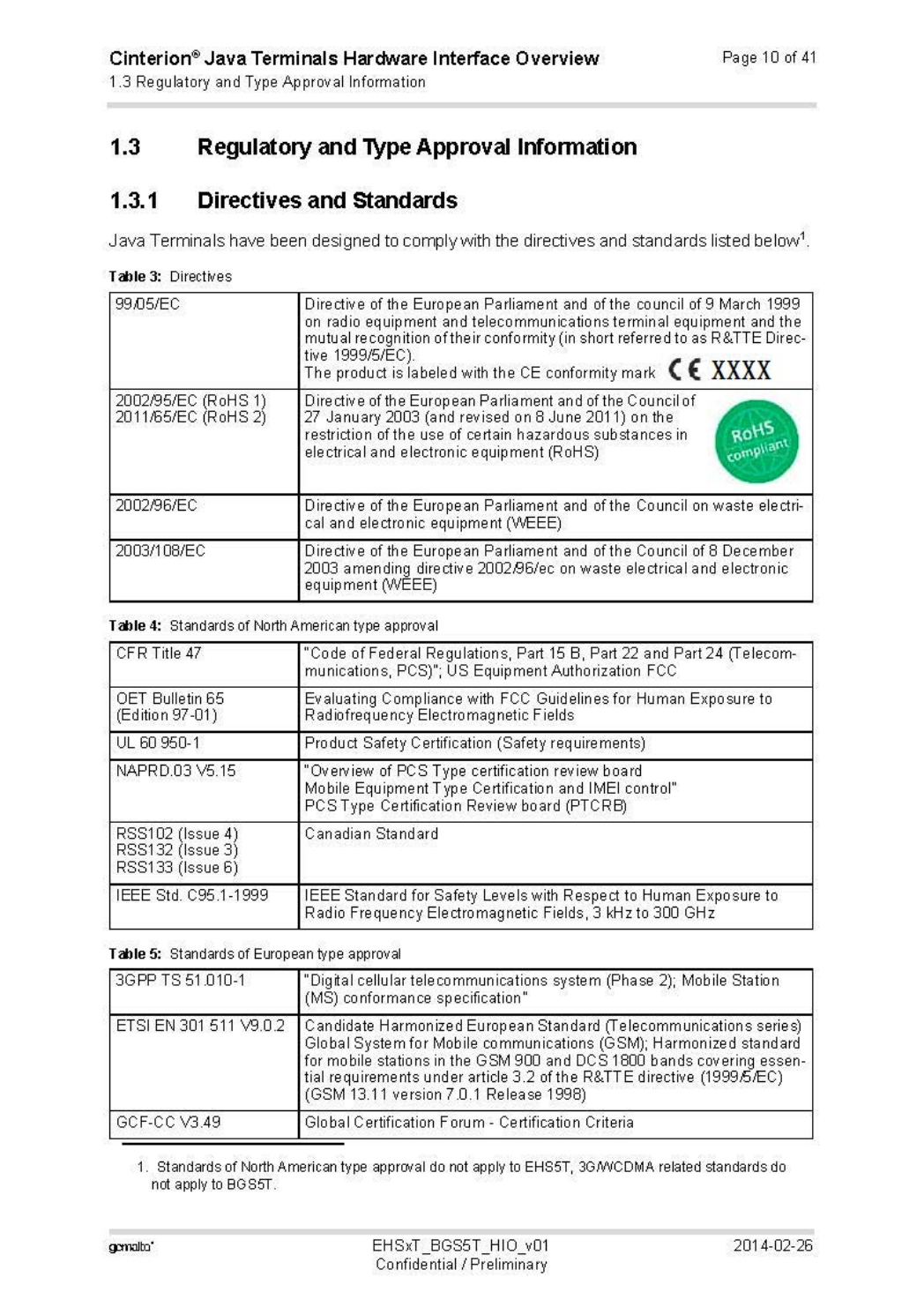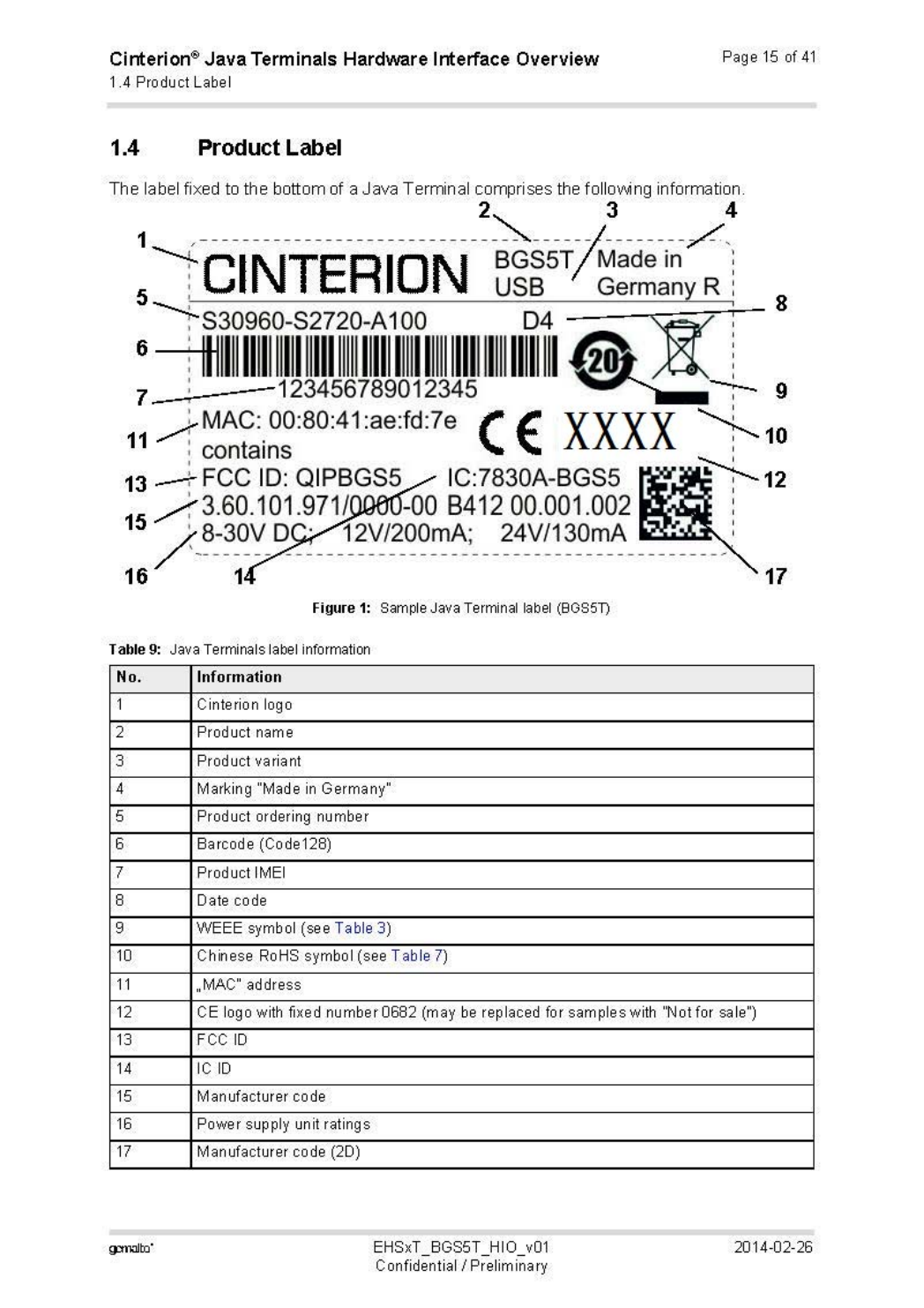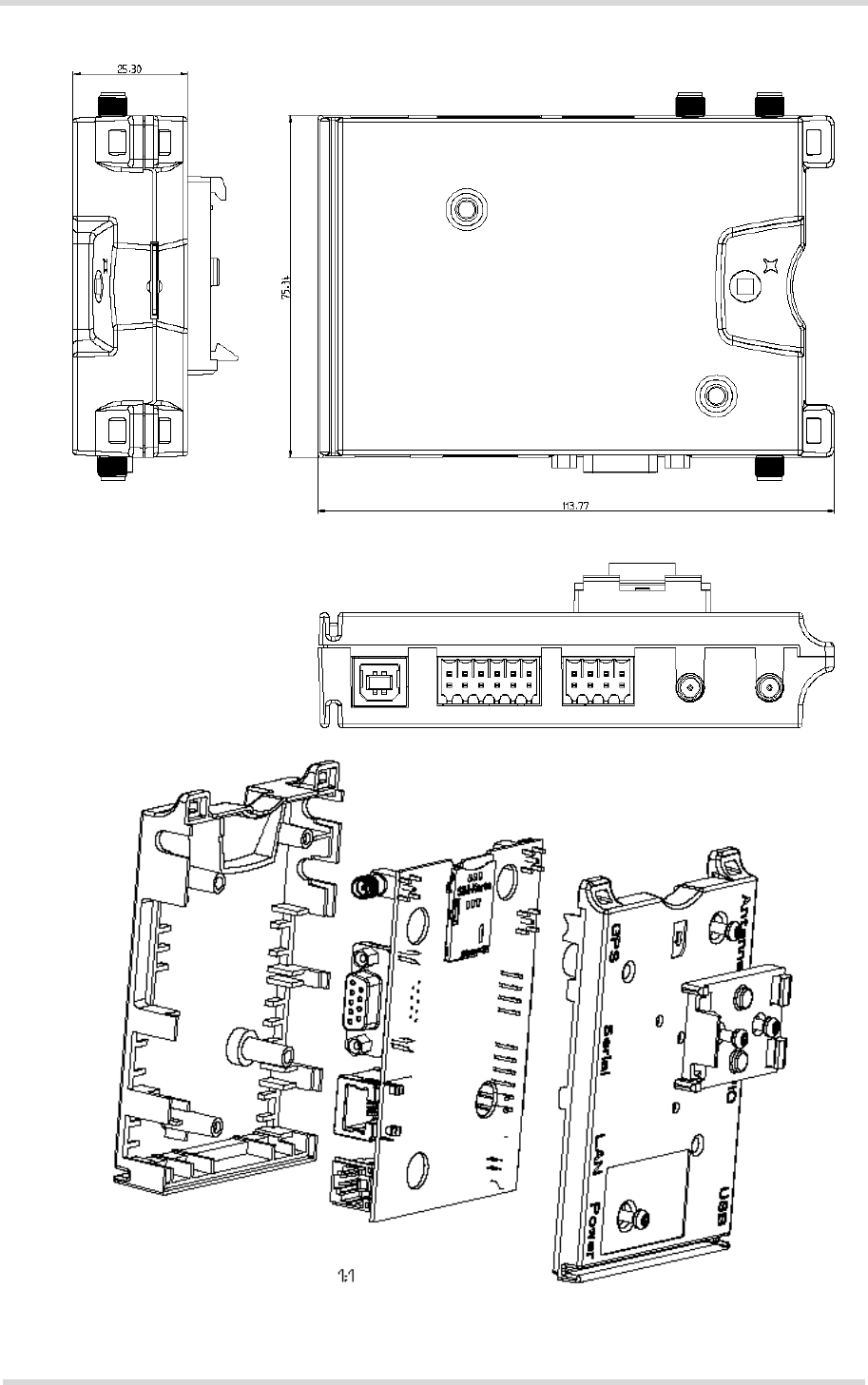THALES DIS AlS Deutschland BGS5 GSM quadband module User Manual hid
Gemalto M2M GmbH GSM quadband module hid
Contents
- 1. _bgs5_hio_V1
- 2. ehsxt_bgsxt_hio_um_V1
ehsxt_bgsxt_hio_um_V1
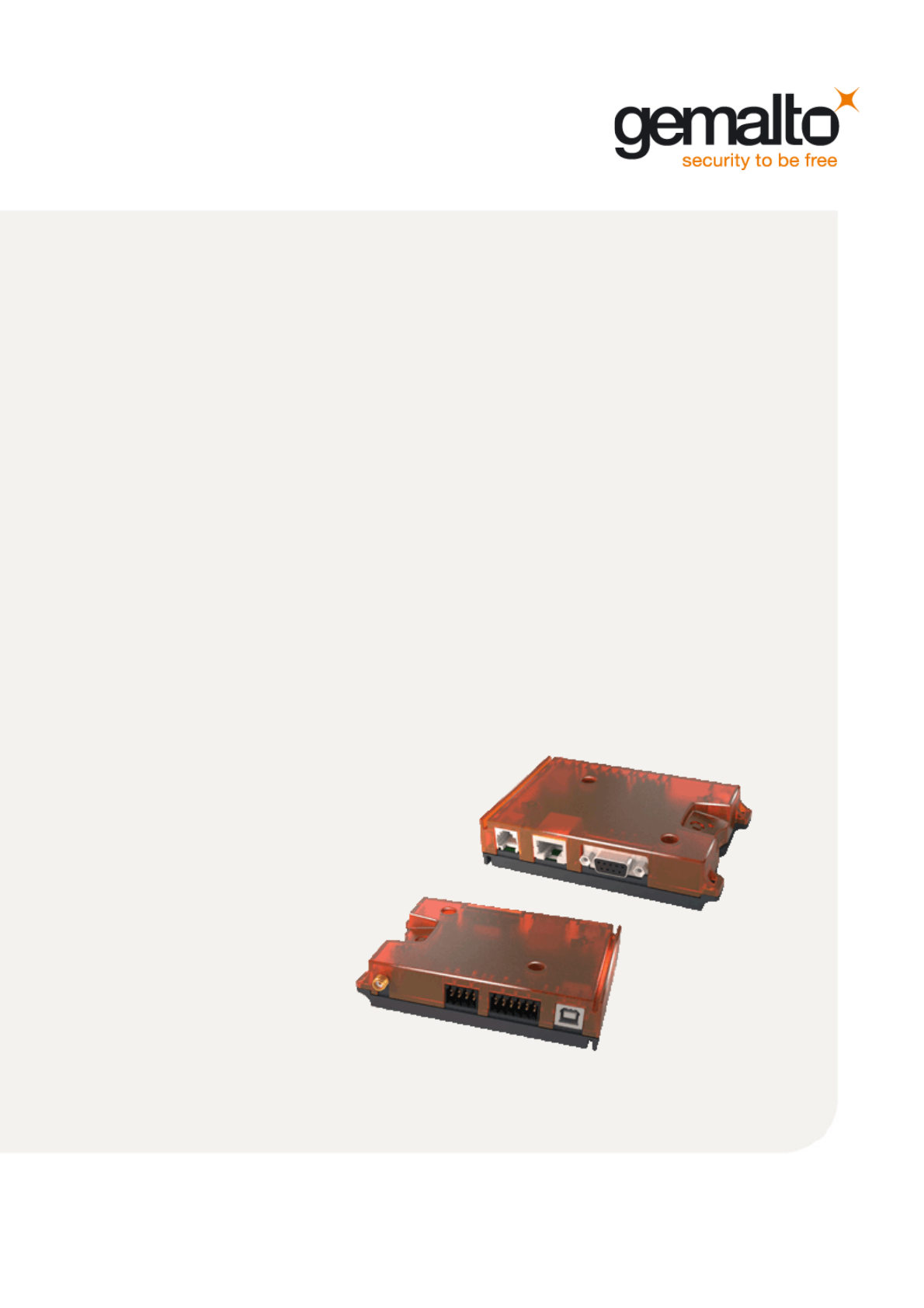
M2M.GEMALTO.COM
Cinterion® Java Terminals
Hardware Interface Overview
Version: 01
DocId: EHSxT_BGS5T_HIO_v01

GENERAL NOTE
THE USE OF THE PRODUCT INCLUDING THE SOFTWARE AND DOCUMENTATION (THE "PROD-
UCT") IS SUBJECT TO THE RELEASE NOTE PROVIDED TOGETHER WITH PRODUCT. IN ANY
EVENT THE PROVISIONS OF THE RELEASE NOTE SHALL PREVAIL. THIS DOCUMENT CONTAINS
INFORMATION ON GEMALTO M2M PRODUCTS. THE SPECIFICATIONS IN THIS DOCUMENT ARE
SUBJECT TO CHANGE AT GEMALTO M2M'S DISCRETION. GEMALTO M2M GMBH GRANTS A NON-
EXCLUSIVE RIGHT TO USE THE PRODUCT. THE RECIPIENT SHALL NOT TRANSFER, COPY,
MODIFY, TRANSLATE, REVERSE ENGINEER, CREATE DERIVATIVE WORKS; DISASSEMBLE OR
DECOMPILE THE PRODUCT OR OTHERWISE USE THE PRODUCT EXCEPT AS SPECIFICALLY
AUTHORIZED. THE PRODUCT AND THIS DOCUMENT ARE PROVIDED ON AN "AS IS" BASIS ONLY
AND MAY CONTAIN DEFICIENCIES OR INADEQUACIES. TO THE MAXIMUM EXTENT PERMITTED
BY APPLICABLE LAW, GEMALTO M2M GMBH DISCLAIMS ALL WARRANTIES AND LIABILITIES.
THE RECIPIENT UNDERTAKES FOR AN UNLIMITED PERIOD OF TIME TO OBSERVE SECRECY
REGARDING ANY INFORMATION AND DATA PROVIDED TO HIM IN THE CONTEXT OF THE DELIV-
ERY OF THE PRODUCT. THIS GENERAL NOTE SHALL BE GOVERNED AND CONSTRUED
ACCORDING TO GERMAN LAW.
Copyright
Transmittal, reproduction, dissemination and/or editing of this document as well as utilization of its con-
tents and communication thereof to others without express authorization are prohibited. Offenders will be
held liable for payment of damages. All rights created by patent grant or registration of a utility model or
design patent are reserved.
Copyright © 2014, Gemalto M2M GmbH, a Gemalto Company
Trademark Notice
Gemalto, the Gemalto logo, are trademarks and service marks of Gemalto and are registered in certain
countries. Microsoft and Windows are either registered trademarks or trademarks of Microsoft Corpora-
tion in the United States and/or other countries. All other registered trademarks or trademarks mentioned
in this document are property of their respective owners.
EHSxT_BGS5T_HIO_v01 2014-02-26
Confidential / Preliminary
Cinterion® Java Terminals Hardware Interface Overview
2
Page 2 of 41
Document Name: Cinterion® Java Terminals Hardware
Interface Overview
Version: 01
Date: 2014-02-26
DocId: EHSxT_BGS5T_HIO_v01
Status Confidential / Preliminary

Cinterion® Java Terminals Hardware Interface Overview
Contents
112
EHSxT_BGS5T_HIO_v01 2014-02-26
Confidential / Preliminary
Page 3 of 41
Contents
0 Document History ...................................................................................................... 6
1 Introduction ................................................................................................................. 7
1.1 Related Documents ........................................................................................... 8
1.2 Terms and Abbreviations................................................................................... 8
1.3 Regulatory and Type Approval Information ..................................................... 10
1.3.1 Directives and Standards.................................................................... 10
1.3.2 Safety Precautions.............................................................................. 13
1.4 Product Label................................................................................................... 15
2 Product Concept ....................................................................................................... 16
2.1 Key Features at a Glance ................................................................................ 16
3 Interface Description ................................................................................................ 19
3.1 Overview.......................................................................................................... 19
3.2 Block Diagram.................................................................................................. 20
3.3 Operating Modes ............................................................................................. 21
3.4 RS-232 Interface.............................................................................................. 22
3.4.1 9-Pole D-sub Connector ..................................................................... 22
3.5 USB Interface................................................................................................... 23
3.6 Weidmueller GPIO Interface............................................................................ 23
3.7 Ethernet Interface ............................................................................................ 25
3.8 Power Supply................................................................................................... 26
3.8.1 Turn Java Terminals on ...................................................................... 27
3.8.2 Reset Java Terminals ......................................................................... 27
3.8.3 Turn Java Terminals off ...................................................................... 27
3.8.4 Disconnecting power supply ............................................................... 28
3.9 Automatic thermal shutdown............................................................................ 29
3.10 RTC.................................................................................................................. 29
3.11 SIM Interface.................................................................................................... 30
3.12 Status LEDs..................................................................................................... 31
3.13 RF Antenna Interface....................................................................................... 32
4 Mechanics, Mounting and Packaging ..................................................................... 33
4.1 Mechanical Dimensions................................................................................... 33
4.2 Mounting the Java Terminals........................................................................... 35
4.3 Packaging ........................................................................................................ 36
5 Full Type Approval.................................................................................................... 37
5.1 Gemalto M2M Reference Setup ...................................................................... 37
5.2 Restrictions ...................................................................................................... 38
5.3 CE Conformity.................................................................................................. 38
5.4 EMC................................................................................................................. 38
5.5 Compliance with FCC Rules and Regulations................................................. 39
6 List of Parts and Accessories.................................................................................. 40

Cinterion® Java Terminals Hardware Interface Overview
Tables
4
EHSxT_BGS5T_HIO_v01 2014-02-26
Confidential / Preliminary
Page 4 of 41
Tables
Table 1: Cinterion® Java Terminals overview ................................................................. 7
Table 2: Terms and abbreviations................................................................................... 8
Table 3: Directives ........................................................................................................ 10
Table 4: Standards of North American type approval ................................................... 10
Table 5: Standards of European type approval............................................................. 10
Table 6: Requirements of quality .................................................................................. 11
Table 7: Standards of the Ministry of Information Industry of the
People’s Republic of China............................................................................. 12
Table 8: Toxic or hazardous substances or elements with defined concentration
limits................................................................................................................ 12
Table 9: Java Terminals label information .................................................................... 15
Table 10: Overview of operating modes ......................................................................... 21
Table 11: 9-pole D-sub (female) RS-232 ........................................................................ 22
Table 12: Weidmueller pin availability............................................................................. 24
Table 13: Female 6-pole Western plug for power supply, ignition, power down............. 26
Table 14: Allowed maximum antenna gain (including cable loss)................................... 32
Table 15: List of parts and accessories........................................................................... 40

Cinterion® Java Terminals Hardware Interface Overview
Figures
5
EHSxT_BGS5T_HIO_v01 2014-02-26
Confidential / Preliminary
Page 5 of 112
Figures
Figure 1: Sample Java Terminal label (BGS5T)............................................................. 15
Figure 2: Java Terminals 3D view.................................................................................. 19
Figure 3: Block diagram ................................................................................................. 20
Figure 4: Pin assignment RS-232 (D-sub 9-pole female)............................................... 22
Figure 5: Weidmueller connectors (8-pin and 12-pin) .................................................... 23
Figure 6: 6-pole Western jack for power supply, ignition, reset, typical connection....... 26
Figure 7: SIM interface................................................................................................... 30
Figure 8: Status LED...................................................................................................... 31
Figure 9: Antenna connector.......................................................................................... 32
Figure 10: Java Terminals 3D overview........................................................................... 33
Figure 11: Java Terminals mechanical dimensions ......................................................... 34
Figure 12: Mounting the Java Terminals.......................................................................... 35
Figure 13: Reference equipment for approval.................................................................. 37

Cinterion® Java Terminals Hardware Interface Overview
1 Introduction
15
EHSxT_BGS5T_HIO_v01 2014-02-26
Confidential / Preliminary
Page 7 of 41
1 Introduction
This document1 describes the hardware of the Cinterion® Java Terminals. The Java Terminals
come in four variants depending on the included Cinterion® module and the available interfac-
es:
•EHS5T contains a Cinterion® EHS5-E module and implements a USB 2.0 interface with a
USB-B connector as well as a 6-pole Western jack as plug-in power supply connector. Via
a Weidmüller GPIO connectors it also implements a RS-485 interface including power sup-
ply and ignition line.
•EHS6T-USB contains a Cinterion® EHS6 module and implements a USB 2.0 interface with
a USB-B connector and also a V.24 / V.28 RS-232 interface with a D-sub 9-pole female
socket as well as a 6-pole Western jack as plug-in power supply connector.
•EHS6T-LAN contains a Cinterion® EHS6 module and implements an Ethernet interface
with a RJ45 8-pin connector and also a V.24 / V.28 RS-232 interface with a D-sub 9-pole
female socket as well as a 6-pole Western jack as plug-in power supply connector.
•BGS5T contains a Cinterion® BGS5 module and implements a USB 2.0 interface with a
USB-B connector and also a V.24 / V.28 RS-232 interface with a D-sub 9-pole female
socket as well as a 6-pole Western jack as plug-in power supply connector.
Wherever necessary and appropriate this document distinguishes between these four variants.
Table 1 gives a short overview of the available interfaces for the different Java Terminals.
The scope of this document includes interface specifications, electrical issues and mechanical
characteristics of Java Terminals. It specifies standards pertaining to wireless applications and
outlines requirements that must be adhered to for successful product design. The Java Termi-
nals are compact GSM/UMTS modems for the transfer of data in GSM/UMTS networks. Indus-
trial standard interfaces and an integrated SIM card reader allow using the Java Terminals
easily as GSM/GPRS/UMTS terminals.
1. The document is effective only if listed in the appropriate Release Notes as part of the technical
documentation delivered with your Cinterion wireless product.
Table 1: Cinterion® Java Terminals overview
Module/Interface EHS5T EHS6T-USB EHS6T-LAN BGS5T
Cinterion® module EHS5-E EHS6 EHS6 BGS5
RS-232 (Sub-D) -
USB (USB-B) -
Weidmüller connector
(GPIOs, SPI, I2C, RS-485)
(no RS-485) (no RS-485) (no RS-485,
no SPI)
Ethernet (RJ45) - - -
Power supply (RJ11)
RF antenna

Cinterion® Java Terminals Hardware Interface Overview
1.1 Related Documents
15
EHSxT_BGS5T_HIO_v01 2014-02-26
Confidential / Preliminary
Page 8 of 41
1.1 Related Documents
[1] AT Command Set for your Java Terminal product
[2] Release Notes for your Java Terminal product
To visit the Gemalto M2M GmbH Website please use the following link:
http://m2m.gemalto.com
1.2 Terms and Abbreviations
Table 2: Terms and abbreviations
Abbreviation Description
ARP Antenna Reference Point
ATC AT Command
BTS Base Transceiver Station
CB Cell Broadcast
CODEC Coder-Decoder
DCE Data Circuit terminating Equipment
DSR Data Set Ready
DTR Data Terminal Ready
EFR Enhanced Full Rate
EGSM Enhanced GSM
EMC Electromagnetic Compatibility
ESD Electrostatic Discharge
ETS European Telecommunication Standard
FDMA Frequency Division Multiple Access
G.C.F. GSM Conformity Forum
GSM Global Standard for Mobile Communication
HW Hardware
IC Integrated Circuit
IF Intermediate Frequency
IMEI International Mobile Equipment Identifier
I/O Input/ Output
IGT Ignition
ISO International Standards Organization
ITU International Telecommunications Union
kbps kbits per second
LVD Low voltage Directive

Cinterion® Java Terminals Hardware Interface Overview
1.2 Terms and Abbreviations
15
EHSxT_BGS5T_HIO_v01 2014-02-26
Confidential / Preliminary
Page 9 of 41
Mbps Mbits per second
MMI Machine Machine Interface
MO Mobile Originated
MS Mobile Station
MT Mobile Terminated
NC Not Connected
NTC Negative Temperature Coefficient
PA Power Amplifier
PCB Printed Circuit Board
PCM Pulse Code Modulation
PCS Personal Communication System
PD Power Down
PDU Protocol Data Unit
R&TTE Radio and Telecommunication Terminal Equipment
RF Radio frequency
RI Ring Indication
RX Receive direction
SIM Subscriber Identification Module
SMS Short Message Service
SW Software
TDD Time Division Duplex
TDMA Time Division Multiple Access
TX Transmit direction
UART Universal Asynchronous Receiver and Transmitter
Table 2: Terms and abbreviations
Abbreviation Description

Cinterion® Java Terminals Hardware Interface Overview
1.3 Regulatory and Type Approval Information
15
EHSxT_BGS5T_HIO_v01 2014-02-26
Confidential / Preliminary
Page 11 of 41
ETSI EN 301 489-1
V1.9.2 Candidate Harmonized European Standard (Telecommunications series)
Electro Magnetic Compatibility and Radio spectrum Matters (ERM); Elec-
tro Magnetic Compatibility (EMC) standard for radio equipment and ser-
vices; Part 1: Common Technical Requirements
ETSI EN 301 489-7
V1.3.1 Candidate Harmonized European Standard (Telecommunications series)
Electro Magnetic Compatibility and Radio spectrum Matters (ERM); Elec-
tro Magnetic Compatibility (EMC) standard for radio equipment and ser-
vices; Part 7: Specific conditions for mobile and portable radio and
ancillary equipment of digital cellular radio telecommunications systems
(GSM and DCS)
ETSI EN 301 489-24
V1.5.1 Electromagnetic Compatibility and Radio spectrum Matters (ERM); Elec-
tromagnetic Compatibility (EMC) standard for radio equipment and ser-
vices; Part 24: Specific conditions for IMT-2000 CDMA Direct Spread
(UTRA) for Mobile and portable (UE) radio and ancillary equipment
ETSI EN 301 908-01
V5.2.1 Electromagnetic compatibility and Radio spectrum Matters (ERM); Base
Stations (BS) and User Equipment (UE) for IMT-2000 Third Generation
cellular networks; Part 1: Harmonized EN for IMT-2000, introduction and
common requirements of article 3.2 of the R&TTE Directive
ETSI EN 301 908-02
V5.2.1 Electromagnetic compatibility and Radio spectrum Matters (ERM); Base
Stations (BS) and User Equipment (UE) for IMT-2000 Third Generation
cellular networks; Part 2: Harmonized EN for IMT-2000, CDMA Direct
Spread (UTRA FDD) (UE) covering essential requirements of article 3.2 of
the R&TTE Directive
EN 62311-2008 Assessment of electronic and electrical equipment related to human expo-
sure restrictions for electromagnetic fields (0 Hz - 300 GHz)
EN 60950-1 (2006)+
A11:2009+A1:2010+
AC:2011+A12:2011
Safety of information technology equipment
Table 6: Requirements of quality
IEC 60068 Environmental testing
DIN EN 60529 IP codes
Table 5: Standards of European type approval
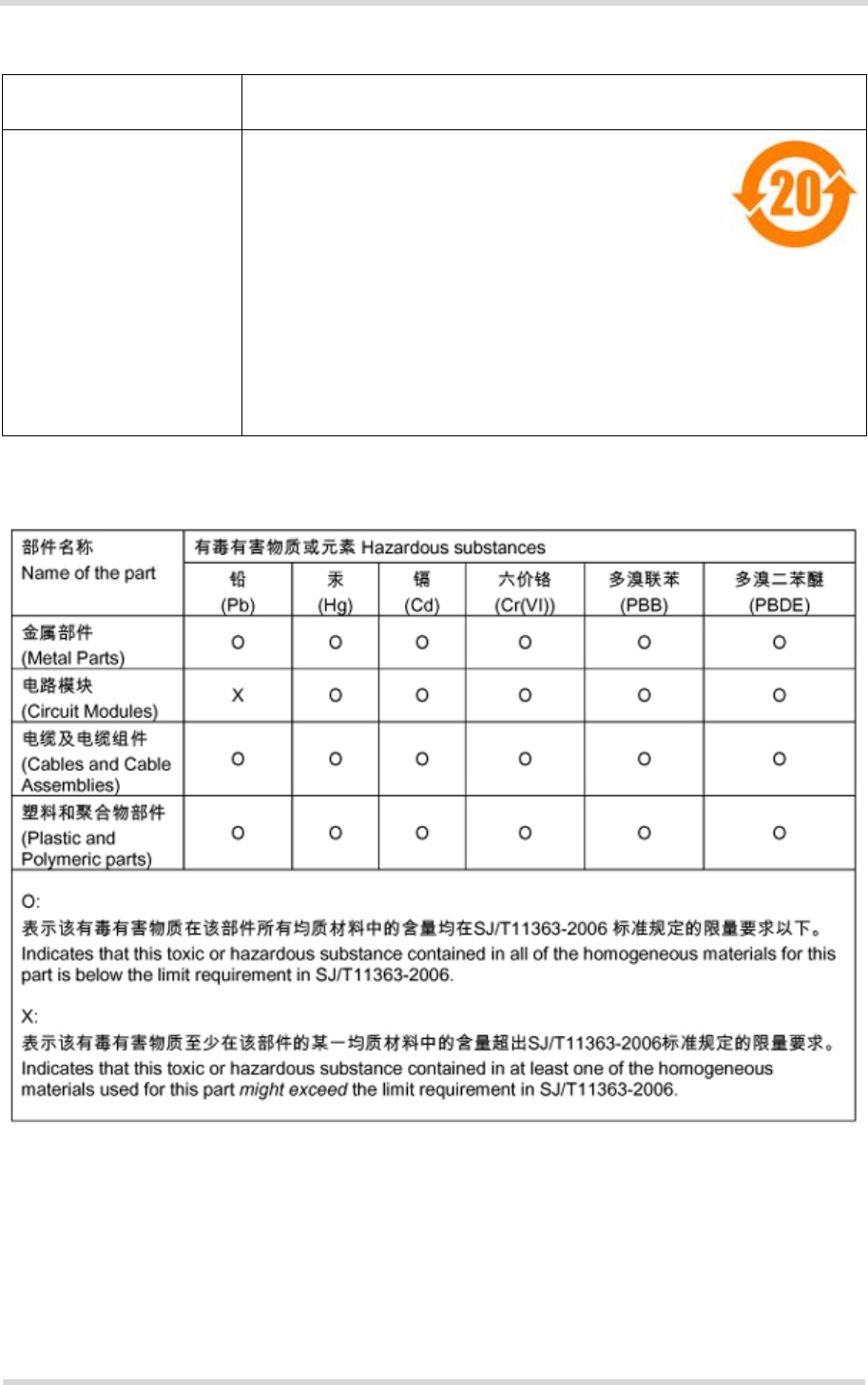
Cinterion® Java Terminals Hardware Interface Overview
1.3 Regulatory and Type Approval Information
15
EHSxT_BGS5T_HIO_v01 2014-02-26
Confidential / Preliminary
Page 12 of 41
Table 8: Toxic or hazardous substances or elements with defined concentration limits
Table 7: Standards of the Ministry of Information Industry of the People’s Republic of China
SJ/T 11363-2006 “Requirements for Concentration Limits for Certain Hazardous Sub-
stances in Electronic Information Products” (2006-06).
SJ/T 11364-2006 “Marking for Control of Pollution Caused by Electronic
Information Products” (2006-06).
According to the “Chinese Administration on the Control
of Pollution caused by Electronic Information Products”
(ACPEIP) the EPUP, i.e., Environmental Protection Use
Period, of this product is 20 years as per the symbol
shown here, unless otherwise marked. The EPUP is valid only as long as
the product is operated within the operating limits described in the Hard-
ware Interface Description.
Please see Table 1.3.2 for an overview of toxic or hazardous substances
or elements that might be contained in product parts in concentrations
above the limits defined by SJ/T 11363-2006.
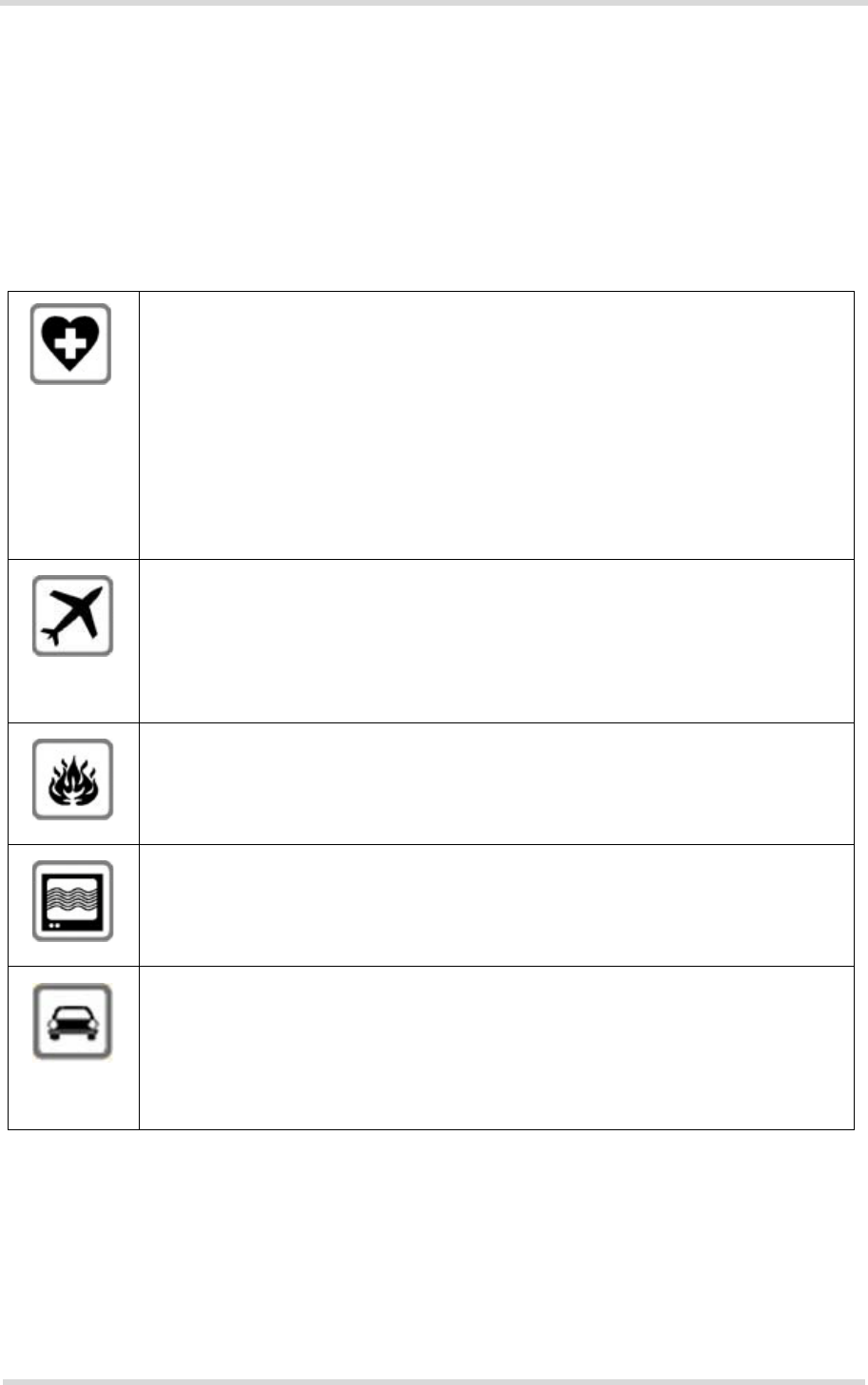
Cinterion® Java Terminals Hardware Interface Overview
1.3 Regulatory and Type Approval Information
15
EHSxT_BGS5T_HIO_v01 2014-02-26
Confidential / Preliminary
Page 13 of 41
1.3.2 Safety Precautions
The following safety precautions must be observed during all phases of the operation, usage,
service or repair of any cellular terminal or mobile incorporating Java Terminals. Manufacturers
of the cellular terminal are advised to convey the following safety information to users and op-
erating personnel and incorporate these guidelines into all manuals supplied with the product.
Failure to comply with these precautions violates safety standards of design, manufacture and
intended use of the product. Cinterion Wireless Modules GmbH assumes no liability for cus-
tomer’s failure to comply with these precautions.
When in hospitals or other health care facilities, observe the restrictions on the use
of mobiles. Switch off the cellular terminal or mobile if to be instructed to do so by
the guidelines posted in sensitive areas. Medical equipment may be sensitive to RF
energy.
The operation of cardiac pacemakers, other implanted medical equipment and
hearing aids can be affected by interference from cellular terminals or mobiles
placed close to the device. If in doubt about potential danger, contact the physician
or the manufacturer of the device to verify that the equipment is properly shielded.
Pacemaker patients are advised to keep their hand-held mobile away from the
pacemaker, while it is on. This personal subgroup always should check the distance
to the mobile.
Switch off the cellular terminal or mobile before boarding an aircraft. Make sure it
cannot be switched on inadvertently. The operation of wireless appliances in an air-
craft is forbidden to prevent interference with communications systems. Failure to
observe these instructions may lead to the suspension or denial of cellular services
to the offender, legal action, or both.
Check the local and actual laws about these themes.
Do not operate the cellular terminal or mobile in the presence of flammable gases
or fumes. Switch off the cellular terminal when you are near petrol stations, fuel
depots, chemical plants or where blasting operations are in progress. Operation of
any electrical equipment in potentially explosive atmospheres can constitute a
safety hazard.
Your cellular terminal or mobile receives and transmits radio frequency energy while
switched on. Remember that interference can occur if it is used close to TV sets,
radios, computers or inadequately shielded equipment. Follow any special regula-
tions and always switch off the cellular terminal or mobile wherever forbidden, or
when you suspect that it may cause interference or danger.
Road safety comes first! Do not use a hand-held cellular terminal or mobile while
driving a vehicle unless it is securely mounted in a holder for speakerphone opera-
tion. Before making a call with a hand-held terminal or mobile park the vehicle.
Speakerphones must be installed by qualified personnel. Faulty installation or oper-
ation can constitute a safety hazard.
Check the actual and local laws about these themes.
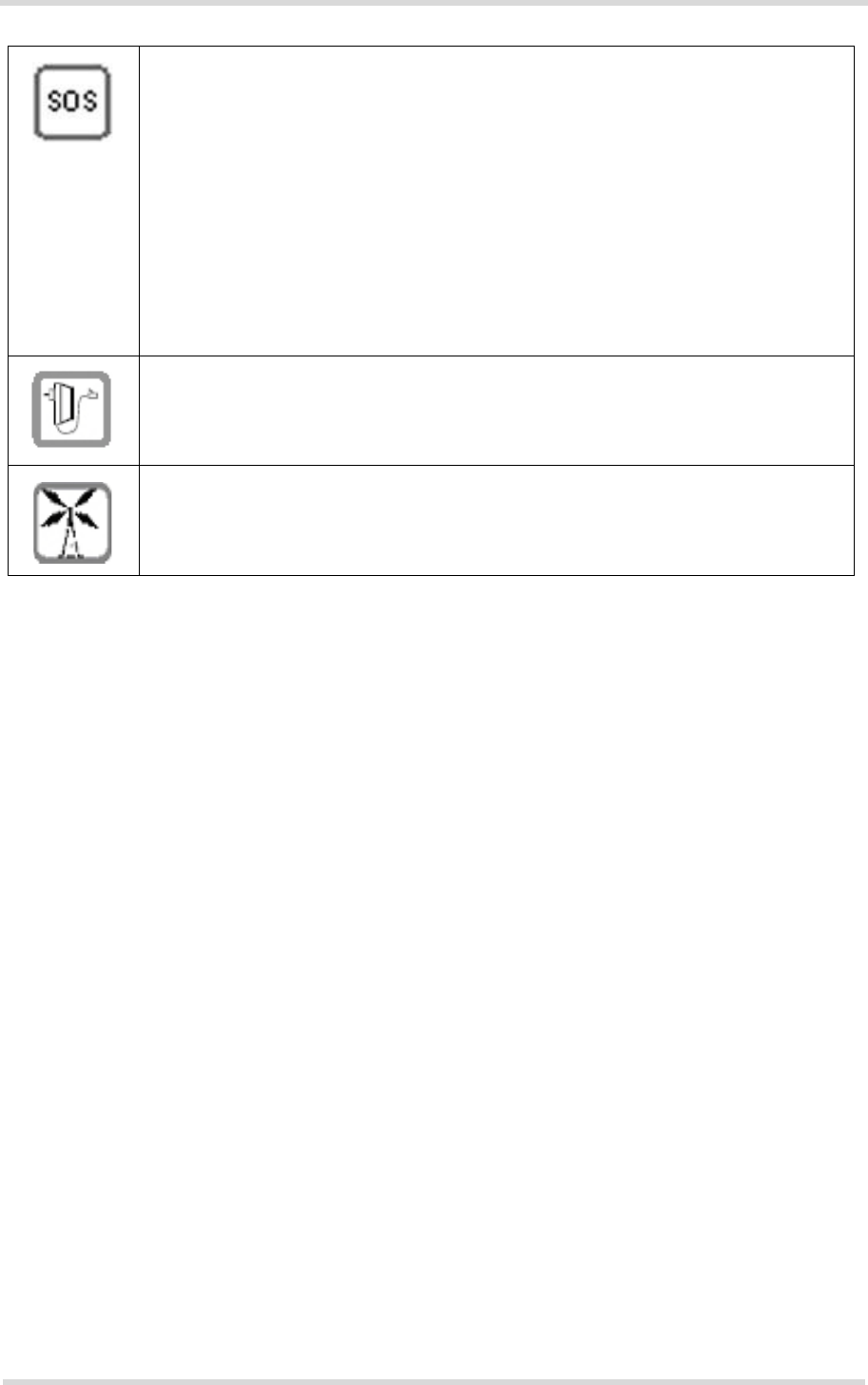
Cinterion® Java Terminals Hardware Interface Overview
1.3 Regulatory and Type Approval Information
15
EHSxT_BGS5T_HIO_v01 2014-02-26
Confidential / Preliminary
Page 14 of 41
IMPORTANT!
Cellular terminals or mobiles operate using radio signals and cellular networks. In
that case connections cannot be guaranteed at all times under all conditions. There-
fore, you should never rely solely upon any wireless device for essential communi-
cations, for example emergency calls.
Remember, in order to make calls or receive calls the cellular terminal or mobile
must be switched on in a service area with adequate cellular signal strength.
Some networks do not allow for emergency calls if certain network services or
phone features are in use (e.g. lock functions, fixed dialing etc.). You may need to
deactivate those features before you can make an emergency call.
Some networks require a valid SIM card to be properly inserted in the cellular ter-
minal or mobile.
If a power supply unit is used to supply the device it must meet the demands placed
on SELV circuits in accordance with EN60950. The maximum permissible connec-
tion length between the device and the supply source should not exceed 3m.
According to the guidelines for human exposure to radio frequency energy, an
antenna connected to the FME jack of the device should be placed at least 20cm
away from human bodies.

Cinterion® Java Terminals Hardware Interface Overview
2 Product Concept
18
EHSxT_BGS5T_HIO_v01 2014-02-26
Confidential / Preliminary
Page 16 of 41
2 Product Concept
2.1 Key Features at a Glance
Feature Implementation
General
Incorporates Cinterion®
Java module The Java module handles all signal and data processing within the Java
Terminals. Internal software runs the application interface and the complete
GSM/GPRS protocol stack.
Frequency bands EHS5T (with EHS5-E module):
GSM/GPRS/EDGE: Dual band GSM 900/1800MHz
UMTS/HSPA+: Dual band UMTS 900/2100MHz
EHS6T-USB (with EHS6 module):
GSM/GPRS/EDGE: Quad band 850/900/1800/1900MHz
UMTS/HSPA+: Five band 800/850/900/1900/2100MHz
EHS6T-LAN (with EHS6 module):
GSM/GPRS/EDGE: Quad band 850/900/1800/1900MHz
UMTS/HSPA+: Five band 800/850/900/1900/2100MHz
BGS5T (with BGS5 module):
Quad band GSM 850/900/1800/1900MHz
GSM class Small MS
Output power (according
to Release 99, V5)
depending on frequency
band supported by mod-
ule
Class 4 (+33dBm ±2dB) for EGSM850
Class 4 (+33dBm ±2dB) for EGSM900
Class 1 (+30dBm ±2dB) for GSM1800
Class 1 (+30dBm ±2dB) for GSM1900
Class E2 (+27dBm ± 3dB) for GSM 850 8-PSK
Class E2 (+27dBm ± 3dB) for GSM 900 8-PSK
Class E2 (+26dBm +3 /-4dB) for GSM 1800 8-PSK
Class E2 (+26dBm +3 /-4dB) for GSM 1900 8-PSK
Class 3 (+24dBm +1/-3dB) for UMTS 2100, WCDMA FDD BdI
Class 3 (+24dBm +1/-3dB) for UMTS 1900,WCDMA FDD BdII
Class 3 (+24dBm +1/-3dB) for UMTS 900, WCDMA FDD BdVIII
Class 3 (+24dBm +1/-3dB) for UMTS 850, WCDMA FDD BdV
Class 3 (+24dBm +1/-3dB) for UMTS 800, WCDMA FDD BdVI
The values stated above are maximum limits. According to Release 99, the
maximum output power in a multislot configuration may be lower. The nom-
inal reduction of maximum output power varies with the number of uplink
timeslots used and amounts to 3.0dB for 2Tx.
Power supply Single supply voltage 8V to 30V
Operating temperature
(EHS5T, EHS6T-USB,
BGS5T only)
Normal operation: -30°C to +85°C
Extended operation: -40°C to -30°C and +85°C to +90°C
Operating temperature
(EHS6T-LAN only) Normal operation: TBD.
Extended operation: TBD.
Physical Dimensions: 113.5mm x 75mm x 25.5mm
(excluding antenna and serial interface connectors)
Weight: 120g (approx.)
RoHS, WEEE All hardware components are fully compliant with the EU RoHS and WEEE
Directives

Cinterion® Java Terminals Hardware Interface Overview
2.1 Key Features at a Glance
18
EHSxT_BGS5T_HIO_v01 2014-02-26
Confidential / Preliminary
Page 17 of 41
HSPA features
3GPP Release 6,7
(EHSxT only) DL 7.2Mbps, UL 5.7Mbps
HSDPA Cat.8 / HSUPA Cat.6 data rates
Compressed mode (CM) supported according to 3GPP TS25.212
UMTS features
3GPP Release 4
(EHSxT only) PS data rate – 384 kbps DL / 384 kbps UL
CS data rate – 64 kbps DL / 64 kbps UL
GSM / GPRS features
Data transfer GPRS:
• Multislot Class 12
• Full PBCCH support
• Mobile Station Class B
• Coding Scheme 1 – 4
EGPRS (EHSxT only):
• Multislot Class 12
• EDGE E2 power class for 8 PSK
• Downlink coding schemes – CS 1-4, MCS 1-9
• Uplink coding schemes – CS 1-4, MCS 1-9
• SRB loopback and test mode B
• 8-bit, 11-bit RACH
• PBCCH support
• 1 phase/2 phase access procedures
• Link adaptation and IR
• NACC, extended UL TBF
• Mobile Station Class B
CSD:
• V.110, RLP, non-transparent
• 2.4, 4.8, 9.6, 14.4kbps
• USSD
SMS • Point-to-point MT and MO
• Cell broadcast
• Text and PDU mode
•
Software
AT commands Hayes 3GPP TS 27.007, TS 27.005, Gemalto M2M
Java™ Open Platform Java™ Open Platform with
• Java™ profile IMP-NG & CLDC 1.1 HI
• Secure data transmission via HTTPS/SSL
• Multi-threading programming and multi-application execution
Major benefits: seamless integration into Java applications, ease of pro-
gramming, no need for application microcontroller, extremely cost-efficient
hardware and software design – ideal platform for industrial GSM applica-
tions.
The memory space available for Java programs is around 8 MB in the flash
file system and around 6MB RAM. Application code and data share the
space in the flash file system and in RAM.
Feature Implementation

Cinterion® Java Terminals Hardware Interface Overview
2.1 Key Features at a Glance
18
EHSxT_BGS5T_HIO_v01 2014-02-26
Confidential / Preliminary
Page 18 of 41
SIM Application Toolkit SAT Release 99
TCP/IP stack Protocols: TCP server/client, UDP, HTTP, FTP, SMTP, POP3
Access by AT commands
Firmware update Upgradeable via serial or USB interface
Interfaces
USB interfaces USB 2.0 Slave interface
RS232 RS-232 interface for AT commands and data:
• Supports RTS/CTS hardware handshake
• Supports software XON/XOFF flow control
• Multiplex ability according to GSM 07.10 Multiplexer protocol
• Baud rates from 1200bps to 230400bps
• Autobauding supported
Weidmueller connector 20-pin (8-pin and 12-pin) header with GPIO interface, external power sup-
ply, ADC, SPI, I²C and RS-485 option
Ethernet TBD.
Power connector 6-pole Western connector (female) for power supply, ignition, power down
signal
SIM card reader Supported SIM cards: 3V, 1.8V
Antenna Antenna connected via female SMA connector
Power on/off, Reset
Power on DTR line at RS-232 interface, IGT_IN line at power connector
Power off Normal switch-off by AT^SMSO or external On/Off push button
Automatic switch-off in case of critical temperature conditions
Reset Orderly shutdown and reset by AT command
Emergency restart via RST_IN line at power connector
Special features
Real time clock Timer functions via AT commands
Phonebook SIM card and terminal
Feature Implementation
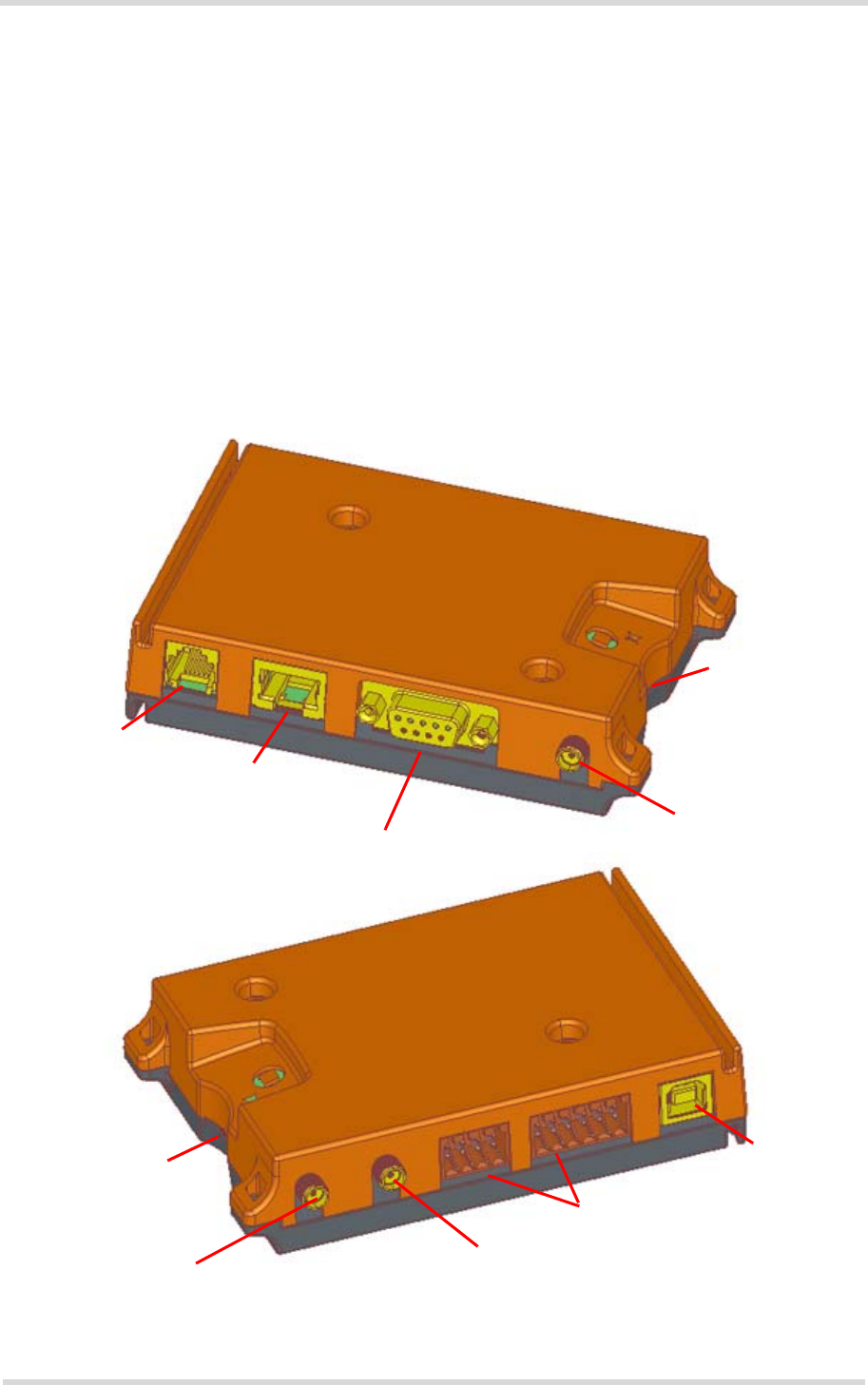
Cinterion® Java Terminals Hardware Interface Overview
3 Interface Description
32
EHSxT_BGS5T_HIO_v01 2014-02-26
Confidential / Preliminary
Page 19 of 41
3 Interface Description
3.1 Overview
Java Terminals provide the following interfaces for power supply, antenna, SIM card and data
transfer:
• 6-pin Western connector (female) for power supply, ignition, power down signal
• SMA antenna connectors (female) for RF antenna and future Rx diversity or GPS antennas
• SIM card reader
• 9-pin (female) D-sub connector (RS-232 interface)
• 4-pin (female) USB-B connector
• 12-pin and 8-pin Weidmueller GPIO connectors (including RS-485)
• 8-pin (female) RJ45 Ethernet connector
Figure 2: Java Terminals 3D view
GPS antenna SMA connector
D-sub socket (RS-232 interface)
Western jack
USB connector
20-pin Weidmueller connector
SIM card reader
SIM card reader
(optional, for future use)
RJ45 Ethernet connector
(8-pin and 12-pin)
RF antenna SMA connector Rx diversity antenna SMA connector
(optional, for future use)
(EHS6T-LAN only)
(not for EHS6T-LAN)
(not for EHS5T)
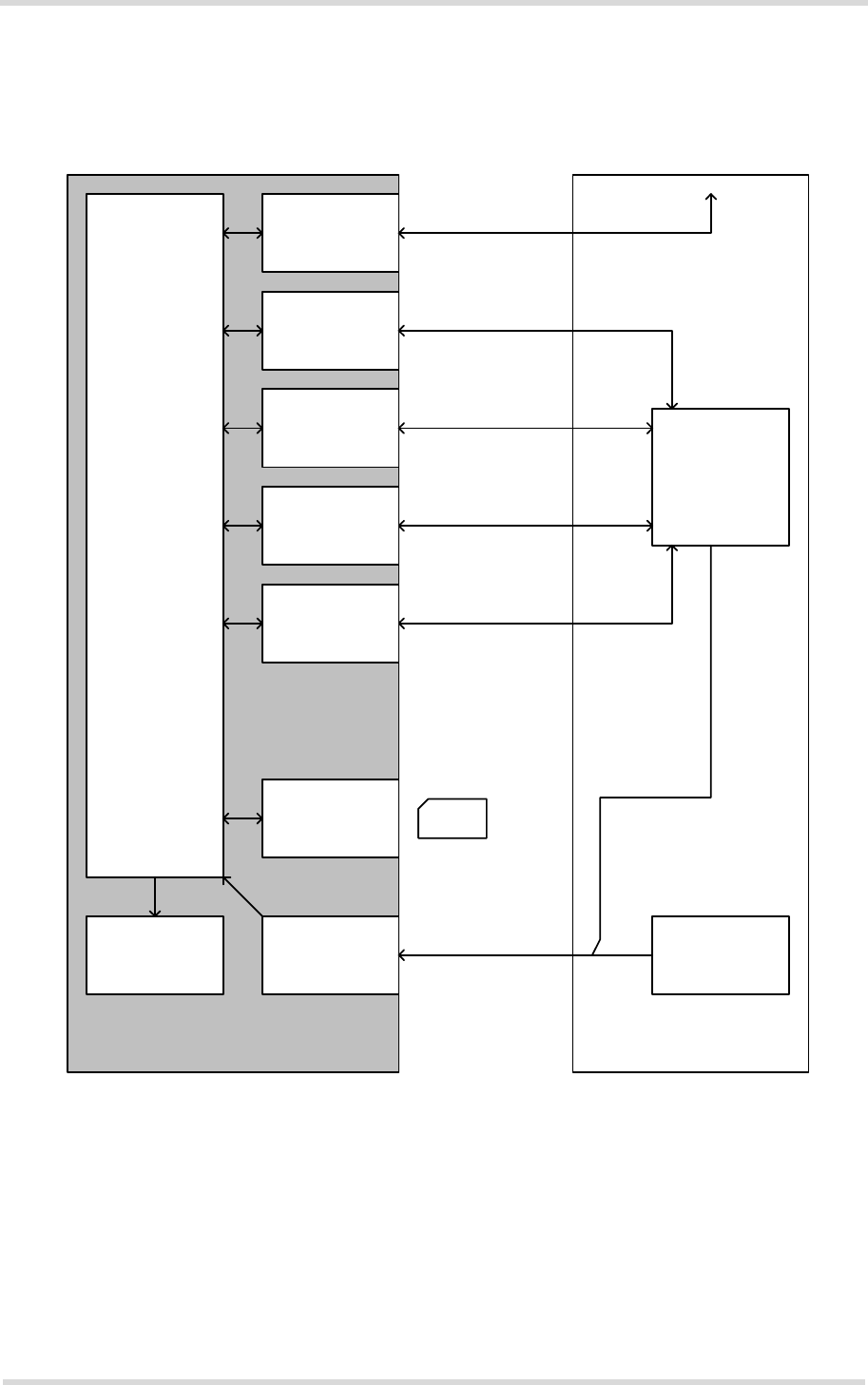
Cinterion® Java Terminals Hardware Interface Overview
3.2 Block Diagram
32
EHSxT_BGS5T_HIO_v01 2014-02-26
Confidential / Preliminary
Page 20 of 41
3.2 Block Diagram
Figure 3 shows a block diagram of a sample configuration that incorporates a Java Terminal
and typical accessories.
Figure 3: Block diagram
Java Terminal
Java
module
RS-232
driver
USB
SIM card
interface
Power regulation
RF antenna
interface
LEDs
RF antenna interface
Host
controller
Power supply
External application
Power supply
SIM
card
Antenna
IGT_IN
RST_IN
Weidmueller
GPIO
driver/interface
Ethernet
interface
EHS6T-LAN only
Not for EHS6T-LAN
Not for EHS5T

Cinterion® Java Terminals Hardware Interface Overview
3.3 Operating Modes
32
EHSxT_BGS5T_HIO_v01 2014-02-26
Confidential / Preliminary
Page 21 of 41
3.3 Operating Modes
The table below briefly summarizes the various operating modes referred to in the following
chapters.
Table 10: Overview of operating modes
Normal operation GSM IDLE Software is active. Once registered to the GSM network
paging with BTS is carried out. The Terminal is ready to
send and receive.
GSM TALK
GSM DATA Connection between two subscribers is in progress.
Power consumption depends on network coverage indi-
vidual settings, such as DTX off/on, FR/EFR/HR, hop-
ping sequences, antenna.
GPRS / UMTS / HSPA
IDLE Terminal is ready for GPRS data transfer, but no data is
currently sent or received. Power consumption depends
on network settings and GPRS configuration (e.g. mul-
tislot settings).
GPRS DATA GPRS data transfer in progress. Power consumption
depends on network settings (e.g. power control level),
uplink / downlink data rates, GPRS configuration (e.g.
used multislot settings) and reduction of maximum out-
put power.
EGPRS DATA
(EHSxT only) EGPRS data transfer in progress. Power consumption
depends on network settings (e.g. power control level),
uplink / downlink data rates, EGPRS configuration (e.g.
used multislot settings) and reduction of maximum out-
put power.
UMTS TALK
UMTS DATA
(EHSxT only)
UMTS data transfer in progress. Power consumption
depends on network settings (e.g. TPC Pattern) and data
transfer rate.
HSPA DATA
(EHSxT only) HSPA data transfer in progress. Power consumption
depends on network settings (e.g. TPC Pattern) and data
transfer rate.
POWER DOWN Normal shutdown after sending the AT^SMSO command.
The RTC works continuously, but the software is not active. Interfaces are not
accessible.
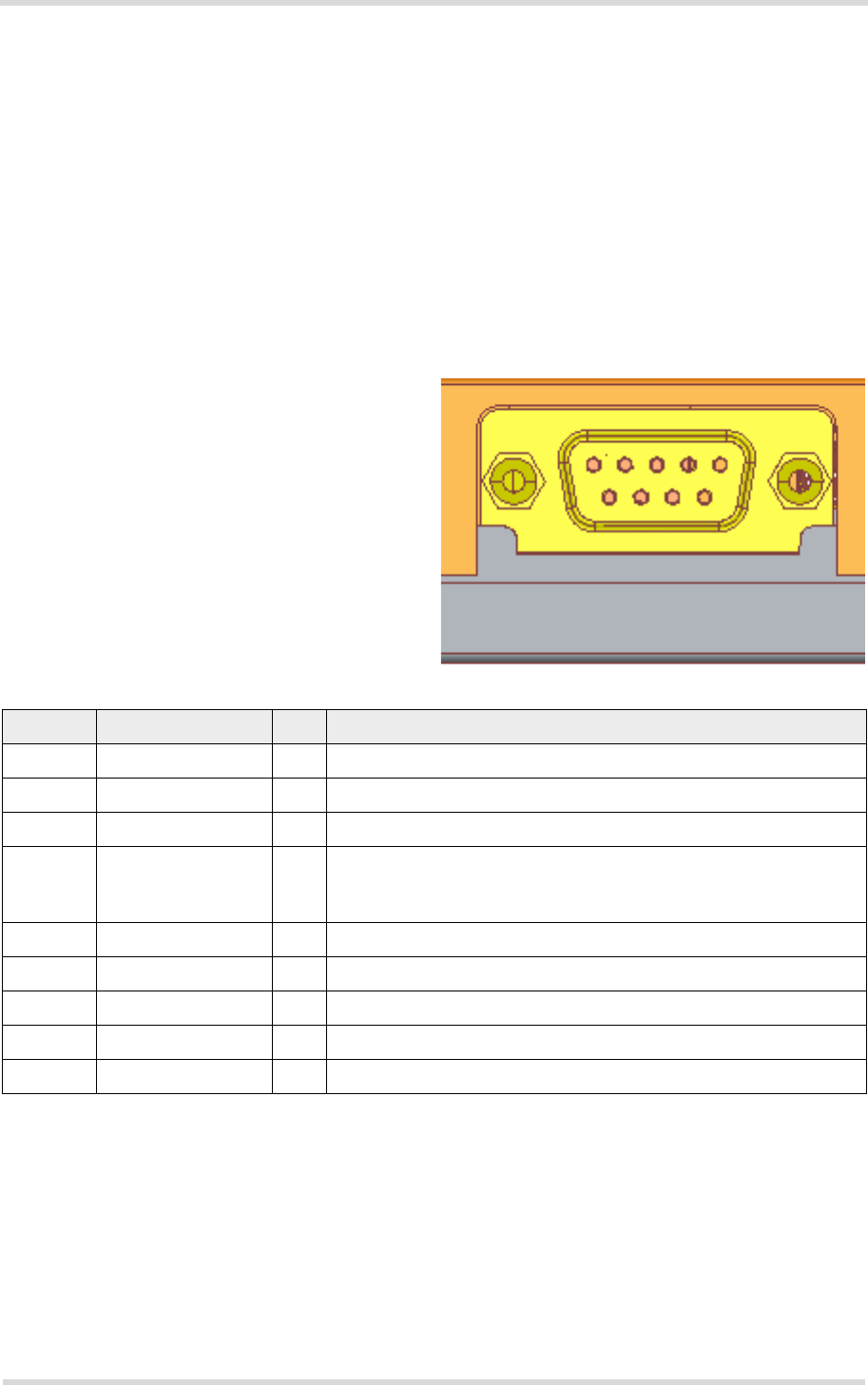
Cinterion® Java Terminals Hardware Interface Overview
3.4 RS-232 Interface
32
EHSxT_BGS5T_HIO_v01 2014-02-26
Confidential / Preliminary
Page 22 of 41
3.4 RS-232 Interface
The RS-232 interface is not available for EHS5T. The interface is implemented as a serial asyn-
chronous transmitter and receiver conforming to ITU-T V.24 Interchange Circuits DCE. It is
configured for 8 data bits, no parity and 1 stop bit, and can be operated at bit rates from
1200bps to 921kbps. Autobauding supports bit rates from 1.2kbps to 230kbps.
For more information see also Section 3.4.1.
3.4.1 9-Pole D-sub Connector
Via RS-232 interface, the host controller controls the Java Terminals and transports data.
Figure 4: Pin assignment RS-232 (D-sub 9-pole female)
Java Terminals are designed for use as a DCE. Based on the conventions for DCE-DTE con-
nections it communicates with the customer application (DTE) using the following signals:
• Port TxD @ application sends data to TXD of the Java Terminals
• Port RxD @ application receives data from RXD of the Java Terminals
Hardware handshake using the RTS and CTS signals and XON/XOFF software flow control
are supported.
Table 11: 9-pole D-sub (female) RS-232
Pin no. Signal name I/O Function
1 DCD O Data Carrier Detected
2RXD OReceive Data
3 TXD I Transmit Data
4 DTR I Data Terminal Ready
Attention: The ignition of Java Terminals is activated via a rising
edge of high potential (+3 ... +15 V)
5 GND - Ground
6 DSR O Data Set Ready
7 RTS I Request To Send
8 CTS O Clear To Send
9 RING O Ring Indication
12345
6789
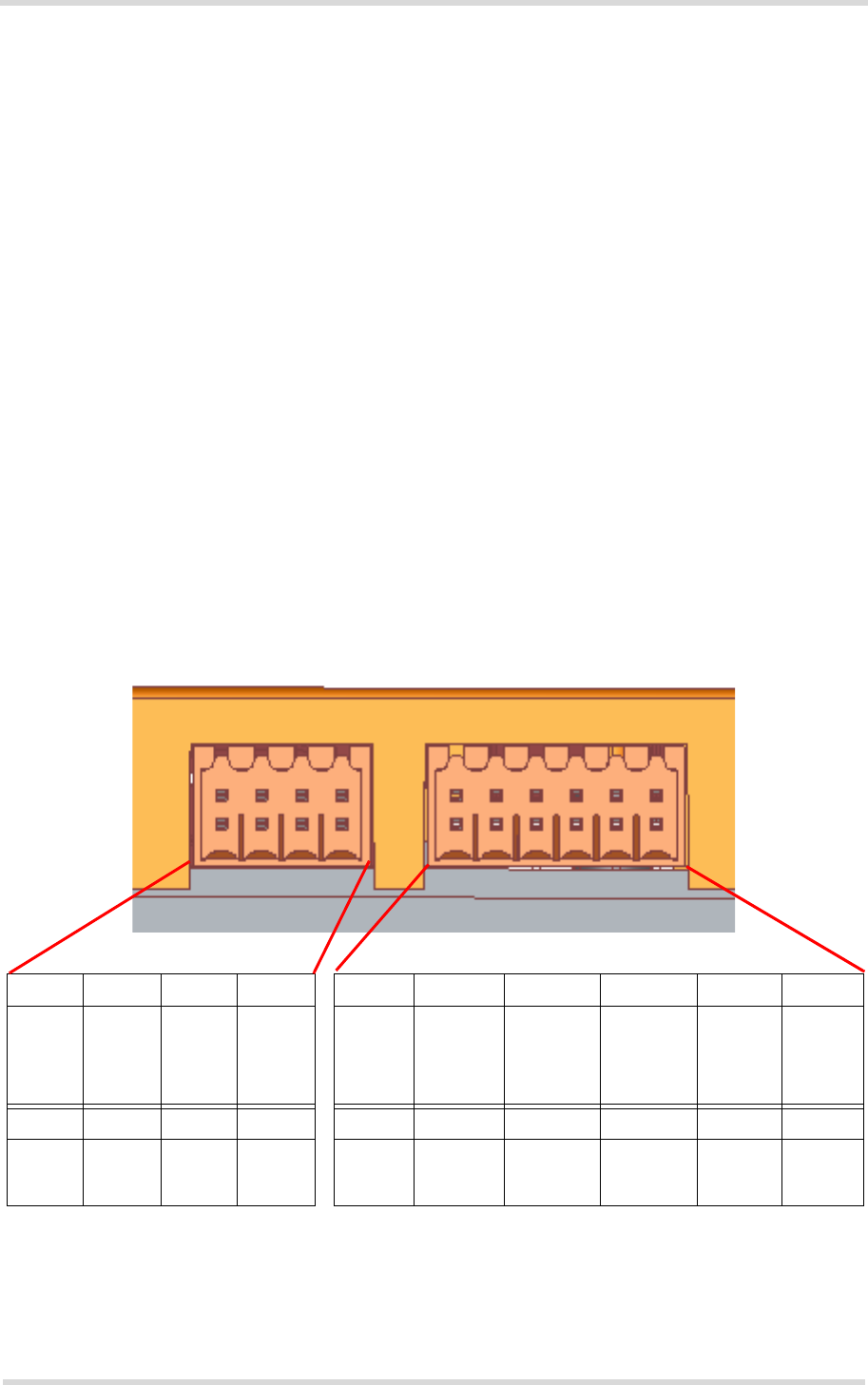
Cinterion® Java Terminals Hardware Interface Overview
3.5 USB Interface
32
EHSxT_BGS5T_HIO_v01 2014-02-26
Confidential / Preliminary
Page 23 of 41
In addition, the modem control signals DTR, DSR, DCD and RING are available. The modem
control signal RING (Ring Indication) can be used to indicate, to the cellular device application,
that a call or Unsolicited Result Code (URC) is received. There are different modes of opera-
tion, which can be set with AT commands.
Note: The DTR signal will only be polled once per second from the internal firmware of Java
Terminals.
3.5 USB Interface
The USB interface is not available for EHS6T-LAN. The other Java Terminals support a USB
2.0 High Speed (480Mbit/s) device interface that is Full Speed (12Mbit/s) compliant.
The USB interface can be used as command and data interface and for downloading firmware.
It is only available as a slave device and not able to act as a USB host.
3.6 Weidmueller GPIO Interface
The Weidmueller connectors provide access to various module signals including a number of
configurable GPIOs.
Figure 5: Weidmueller connectors (8-pin and 12-pin)
1234 1 2 3 4 5 6
GPIO6 GPIO7 GPIO8 GPIO11 VCCref GND TXD1/
SPI_MISO RXD1/
SPI_MOSI CTS1
(RS232)/
A+
(RS485)/
SPI_CS
RTS1
(RS232/
B-
(RS485)
5678 7 8 9 10 1112
GPIO12 GPIO13 GPIO14 GPIO15 +5Vout DSR0/
ADC1_IN/
SPI_CLK
I2CDAT I2CCLK GPIO20 GPIO21

Cinterion® Java Terminals Hardware Interface Overview
3.6 Weidmueller GPIO Interface
32
EHSxT_BGS5T_HIO_v01 2014-02-26
Confidential / Preliminary
Page 24 of 41
The following Table 12 shows the availablility of the Weidmueller pins for various Java Terminal
variants.
Please refer to the respective “AT Command Set“ for details on how to configure the GPIO pins.
Table 12: Weidmueller pin availability
PIN Signal Comment EHS5T EHS6T-
USB EHS6T-
LAN BGS5T
8-pin connector
1 GPIO6 Configurable via AT command,
also as PWM2 signal
2 GPIO7 Configurable via AT command,
also as PWM1 signal
3 GPIO8 Configurable via AT command,
also as COUNTER signal
4 GPIO11 Configurable via AT command - -
5 GPIO12 Configurable via AT command - -
6 GPIO13 Configurable via AT command - -
7 GPIO14 Configurable via AT command - -
8 GPIO15 Configurable via AT command - -
12-pin connector
1 VCCref Input supply for level converter to
specify external power level
(e.g., connect +5Vout for 5V
power level)
2GND
3 TXD1 Configurable via AT command,
also as SPI_MISO signa
(no SPI)
4 RXD1 Configurable via AT command,
also as SPI_MOSI signal
(no SPI)
5CTS1
or
A+
Either CTS1 (for RS-232) or
SPI_CS or A+ (for RS-485)
depending on product variant
A+ CTS1 CTS1 CTS1
(no SPI)
6RTS1
or
B-
Either RTS1 (for RS-232) or B-
(for RS-485) depending on prod-
uct variant
B- RTS1 RTS1 RTS1
7 +5Vout External power supply up to
100mA, usable as VCCref input
8 DSR0 or
ADC1_IN or
SPI_CLK
Configurable via AT command
(no SPI)
9 I2CDAT I2C interface
10 I2CCLK I2C interface
11 GPIO20 Configurable via AT command
12 GPIO21 Configurable via AT command

Cinterion® Java Terminals Hardware Interface Overview
3.7 Ethernet Interface
32
EHSxT_BGS5T_HIO_v01 2014-02-26
Confidential / Preliminary
Page 25 of 41
EHS5T‘s RS-485 interface is based on the TIA/EIA-485 standard defining electrical character-
istics of drivers and receivers for use in balanced multidrop communication systems. RS-485
is used in a lot of different fieldbus systems like Profibus, Interbus, Modbus and P-net.
RS-485 uses a shielded twisted pair cable where the shield is used as ground return, and the
inner pairs are used for balanced communication. The two conductors in each pair are called
A and B. RS-485 is usually half-duplex.
Data transmission speed depends on the length of the RS-485 bus cable and may be up to
115kbps.
3.7 Ethernet Interface
TBD.
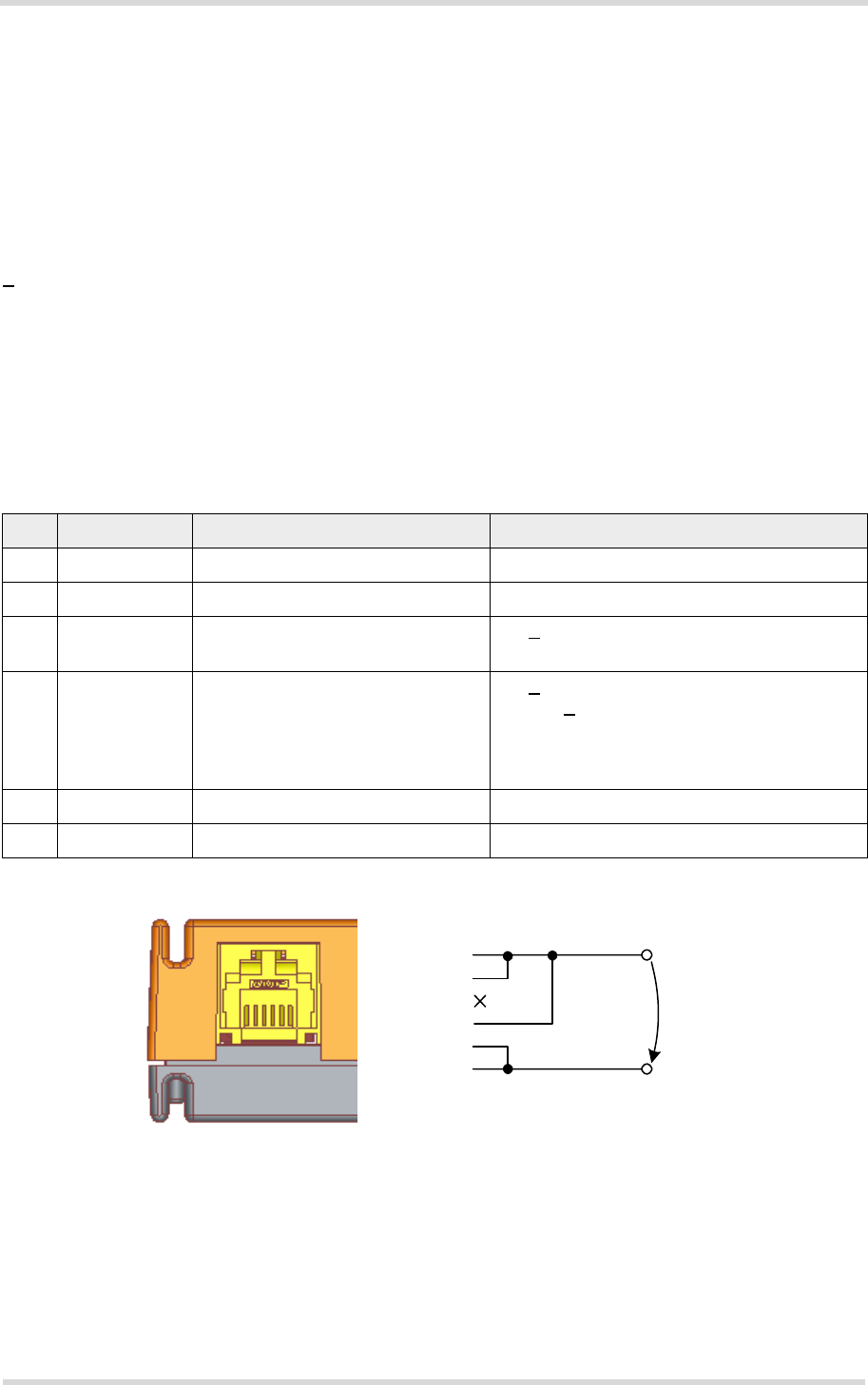
Cinterion® Java Terminals Hardware Interface Overview
3.8 Power Supply
32
EHSxT_BGS5T_HIO_v01 2014-02-26
Confidential / Preliminary
Page 26 of 41
3.8 Power Supply
The power supply of the Java Terminals has to be a single voltage source of VPLUS=8V…30V
capable of providing a peak current (pulsed 2x577ms at T=4.615ms) of about TBD.A at 12V
during an active transmission. The uplink burst causes strong ripple (drop) on the power lines.
The drop voltage should not exceed 1V, but the absolute minimum voltage during drops must
be >7.6V.
The Java Terminals are protected from supply voltage reversal. An external fast acting fuse
>0.4A with melting integral I2t (0.15 … 0.25)A2s is necessary to use the Java Terminals at a
12V or 24V unlimited power supply system.
The power supply must be compliant with the EN60950 guidelines. A switching regulator reg-
ulates the input voltage for the internal supply.
When power fails for >1ms, Java Terminals reset or switch off. When power fails for >15s the
RTC will be reset.
Figure 6: 6-pole Western jack for power supply, ignition, reset, typical connection
Mains adapter: If it fits into the design of your application we recommend the plug-in supply unit
used with the type approved Gemalto M2M reference setup. Ordering information can be found
in Chapter 6. This 12V mains adapter comes with a 6-pole Western plug and provides an inter-
nal connection between IGT_IN pin and PLUS pin for auto ignition (power up).
Table 13: Female 6-pole Western plug for power supply, ignition, power down
Pin Signal name Use Parameters
1 PLUS Power supply 8V – 30V DC, max. 33V for 1 min
2 PLUS Power supply 8V – 30V DC, max. 33V for 1 min
3 RST_IN Signal for module reset UIH > 8V for t>10ms resets the terminal.
UIL <2V and low level for normal operation.
4 IGT_IN Ignition UIH >8V
Ignition >8V for more than 200ms switches
the Java Terminals on. Ignition is activated
only by a rising edge. The rise time is
<20ms
5 GND Ground 0V
6 GND Ground 0V
Pin assignmment and typical connection:
1 PLUS
2 PLUS
3 RST_IN
4 IGT_IN
5 GND
6 GND
VPLUS DC
6 5 4 3 2 1

Cinterion® Java Terminals Hardware Interface Overview
3.8 Power Supply
32
EHSxT_BGS5T_HIO_v01 2014-02-26
Confidential / Preliminary
Page 27 of 41
3.8.1 Turn Java Terminals on
Java Terminals are turned on by plugging an appropriate power supply unit between PLUS and
GND of the 6-pole Western jack.
While the RST_IN pin (pin 3) is not active (voltage <2V) you can start the Java Terminals by
activating the RS-232 DTR line if in POWER DOWN mode.
The IGT_IN signal (pin 4) may be used to switch on Java Terminals if in POWER DOWN mode.
After startup of the Java Terminals the RS-232 lines are in an undefined state for approx.
900ms. This may cause undefined characters to be transmitted over the RS-232 lines during
this period.
3.8.2 Reset Java Terminals
An easy way to reset the Java Terminals is entering the command AT+CFUN=x,1. For details
on AT+CFUN please see [1].
As an alternative, you can shut down the Java Terminals as described in Section 3.8.3 and then
restart it as described in Section 3.8.1.
3.8.3 Turn Java Terminals off
Normal shutdown:
• To turn off the Java Terminals use the AT^SMSO command, rather than disconnecting the
mains adapter.
This procedure lets the Java Terminals log off from the network and allows the software to
enter a secure state and save data before disconnecting the power supply. After AT^SMSO
has been entered the Java Terminals returns the following result codes:
^SMSO: MS OFF
OK
^SHUTDOWN
The "^SHUTDOWN" result code indicates that the Java Terminals turns off in less than
1 second. After the shutdown procedure is complete the Java Terminals enters the
POWER DOWN mode. The yellow LED stops flashing (see Section 3.12 for a detailed LED
description). The RTC is still fed from the voltage regulator in the power supply ASIC.
Please note that if there is an auto ignition connection between PLUS and IGT_IN the mod-
ule will restart automatically after a normal shutdown.

Cinterion® Java Terminals Hardware Interface Overview
3.8 Power Supply
32
EHSxT_BGS5T_HIO_v01 2014-02-26
Confidential / Preliminary
Page 28 of 41
Emergency restart:
• In the event of software hang-ups etc. the Java Terminals can be restarted by applying a
voltage >8V to the RST_IN pin (pin 3) for more than 10ms.
The RST_IN signal restarts the Java Terminals.
Caution: Use the RST_IN pin only when, due to serious problems, the software is not
responding for more than 5 seconds. Pulling the RST_IN pin causes the loss of all informa-
tion stored in the volatile memory since power is cut off immediately. Therefore, this proce-
dure is intended only for use in case of emergency, e.g. if Java Terminals fails to shut down
properly.
When the Java Terminals enter the Power Down mode, e.g., after you have issued the
AT^SMSO command or activated the RST_IN signal, all RS-232 interface lines are active for
a period of 50ms to max. 3.5s. This may cause undefined characters to be transmitted on the
RS-232 lines which can be ignored.
3.8.4 Disconnecting power supply
Before disconnecting the power supply from the PLUS pin, make sure that the Java Terminals
are in a safe condition. The best way is to wait 1s after the "^SHUTDOWN" result code has
been indicated.
11

Cinterion® Java Terminals Hardware Interface Overview
3.9 Automatic thermal shutdown
32
EHSxT_BGS5T_HIO_v01 2014-02-26
Confidential / Preliminary
Page 29 of 41
3.9 Automatic thermal shutdown
An on-board NTC measures the temperature of the built-in BGS2 module. If over- or undertem-
perature is detected on the module the Java Terminals automatically shut down to avoid ther-
mal damage to the system. Table 17 specifies the ambient temperature threshold for the Java
Terminals.
The automatic shutdown procedure is equivalent to the power-down initiated with the
AT^SMSO command, i.e. Java Terminals log off from the network and the software enters a
secure state avoiding loss of data. In IDLE mode it takes typically one minute to deregister from
the network and to switch off.
Alert messages transmitted before the Java Terminals switch off are implemented as Unsolic-
ited Result codes (URCs). For details see the description of AT^SCTM command provided in
[1].
Thermal shutdown will be deferred if a critical temperature limit is exceeded, while an emer-
gency call or a call to a predefined phone number is in progress, or during a two minute guard
period after power up. See [1] for details.
3.10 RTC
The internal Real Time Clock (RTC) of the Java Terminals retain the time and date and handle
the alarm (reminder) function. The AT+CCLK command serves to set the time and date, and
AT+CALA specifies a reminder message. See [1] for details.
A dedicated voltage regulator backs up the RTC even in POWER DOWN mode and enables
Java Terminals to keep track of time and date.
However, please note that the Alarm mode described in [1], Section AT+CALA, is not intended
for the Java Terminals. The AT+CALA command can only be used to set a reminder message,
but not to configure the mobile to wake up from POWER DOWN mode into Alarm mode. There-
fore, after setting a timer with AT+CALA be sure not to shut down the Java Terminals by
AT^SMSO or RST_IN signal.
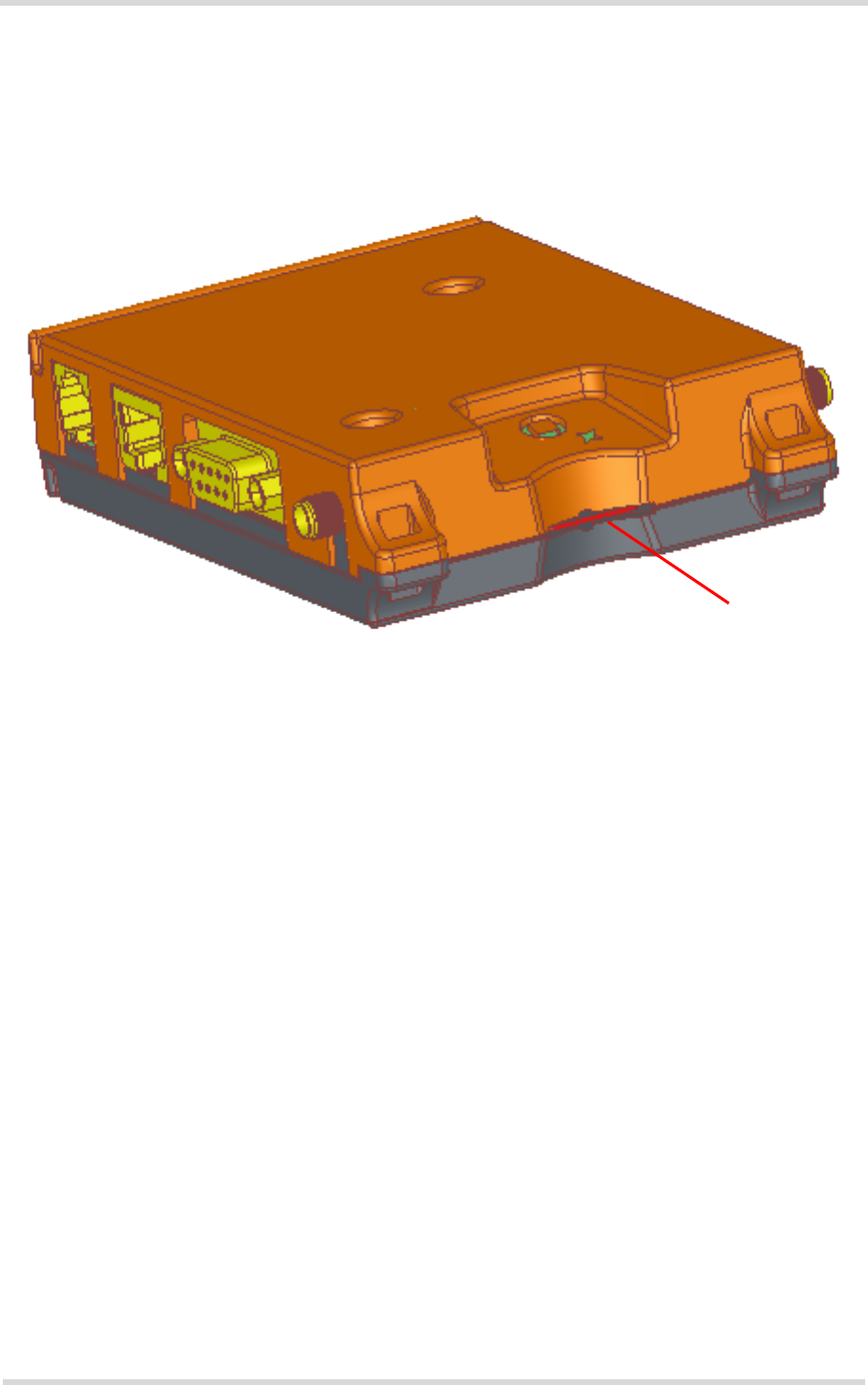
Cinterion® Java Terminals Hardware Interface Overview
3.11 SIM Interface
32
EHSxT_BGS5T_HIO_v01 2014-02-26
Confidential / Preliminary
Page 30 of 41
3.11 SIM Interface
The SIM interface is intended for 1.8V and 3V SIM cards in accordance with GSM 11.12 Phase
2. The card holder is a five wire interface according to GSM 11.11. A sixth pin has been added
to detect whether or not a SIM card is inserted.
Figure 7: SIM interface
The SIM - with the circuit side facing upwards - is inserted by gently pushing it into the SIM card
holder until it snaps hold. It is now protected from accidental removal. The SIM can be removed
from the card holder by using a flat object such as a screwdriver to carefully press the inserted
SIM until it snaps out again.
All signals of the SIM interface are protected from electrostatic discharge with spark gaps to
GND and clamp diodes to 1.8V resp. 2.9V and GND.
Removing and inserting the SIM card during operation requires the software to be reinitialized.
Therefore, after reinserting the SIM card it is necessary to restart Java Terminals.
Note: No guarantee can be given, nor any liability accepted, if loss of data is encountered after
removing the SIM card during operation. Also, no guarantee can be given for properly initializ-
ing any SIM card that the user inserts after having removed a SIM card during operation. In this
case, the application must restart the Java Terminals.
SIM inserted
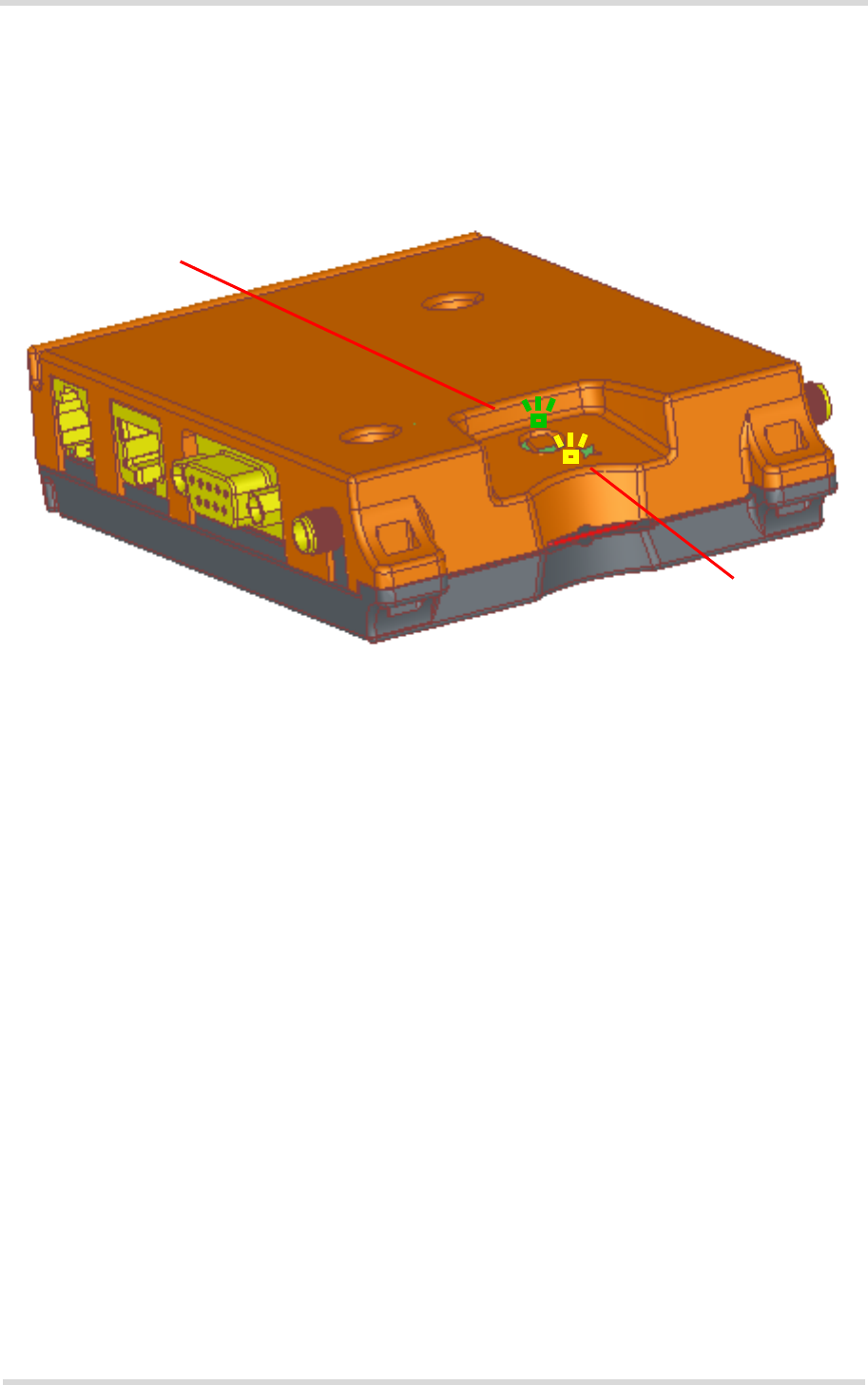
Cinterion® Java Terminals Hardware Interface Overview
3.12 Status LEDs
32
EHSxT_BGS5T_HIO_v01 2014-02-26
Confidential / Preliminary
Page 31 of 41
3.12 Status LEDs
Java Terminals have two LEDs indicating its operating states through the semitransparent cas-
ing:
• A green LED indicates whether the Java Terminals are ready to operate.
• A yellow LED indicates the network registration state of the Java Terminals.
Figure 8: Status LED
The yellow LED is driven by a line of the integrated module that can be configured by using the
AT^SLED command to either light permanently or to flash. For details on the AT command
please refer to [1].
Green LED
(Power on/off)
Yellow LED
(Network status)
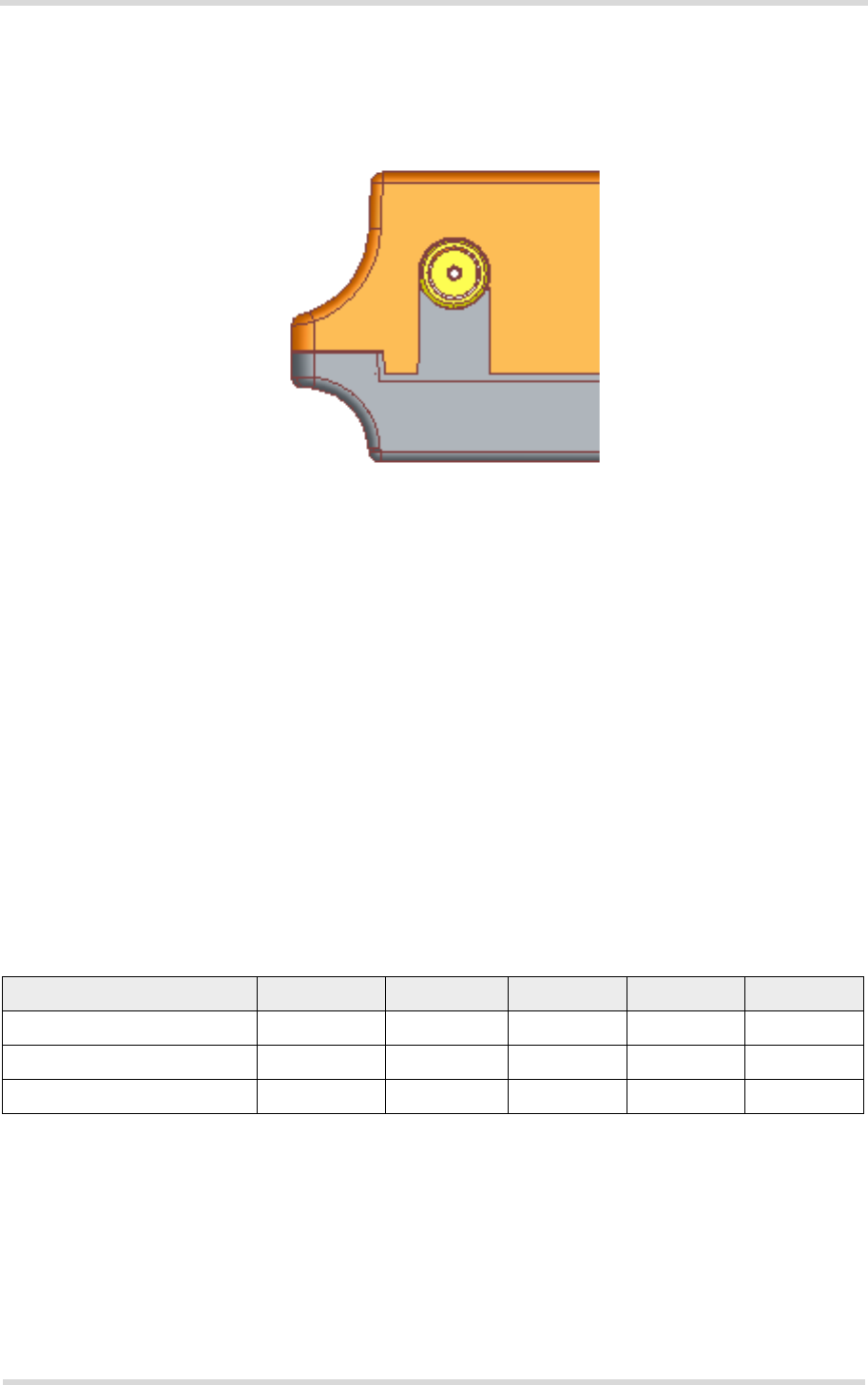
Cinterion® Java Terminals Hardware Interface Overview
3.13 RF Antenna Interface
32
EHSxT_BGS5T_HIO_v01 2014-02-26
Confidential / Preliminary
Page 32 of 41
3.13 RF Antenna Interface
An external RF antenna is connected via the Java Terminals’s female SMA connector that is
also the antenna reference point (ARP).
Figure 9: Antenna connector
The system impedance is 50. In any case, for good RF performance, the return loss of the
customer application’s antenna should be better than 10dB (VSWR < 2). Java Terminals with-
stand a total mismatch at this connector when transmitting with power control level for maxi-
mum RF power.
Inside the Java module an inductor to ground provides additional ESD protection to the anten-
na connector. To protect the inductor from damage no DC voltage must be applied to the an-
tenna circuit.
For the application it is recommended to use an antenna with an SMA (male) connector:
Please note that the terminal should be installed and operated with a minimum distance of
20cm between the antenna connected to the terminal and any human bodies. Also, the trans-
mitter must not be co-located or operating in conjunction with any other antenna or transmitter.
The allowed maximum antenna gain (including cable loss) for stand-alone situation is given be-
low in Table 14.
Table 14: Allowed maximum antenna gain (including cable loss)
Module 850MHz 900MHz 1800MHz 1900MHz 2100MHz
EHS6T-USB/EHS6-LAN 3.42dBi 4.18dBi 9.64dBi 2.51dBi 15.54dBi
BGS5T 2.15dBi 2.15dBi 2.15dBi 2.15dBi na
EHS5T na 6.10dBi 12.30dBi na 12.30dBi
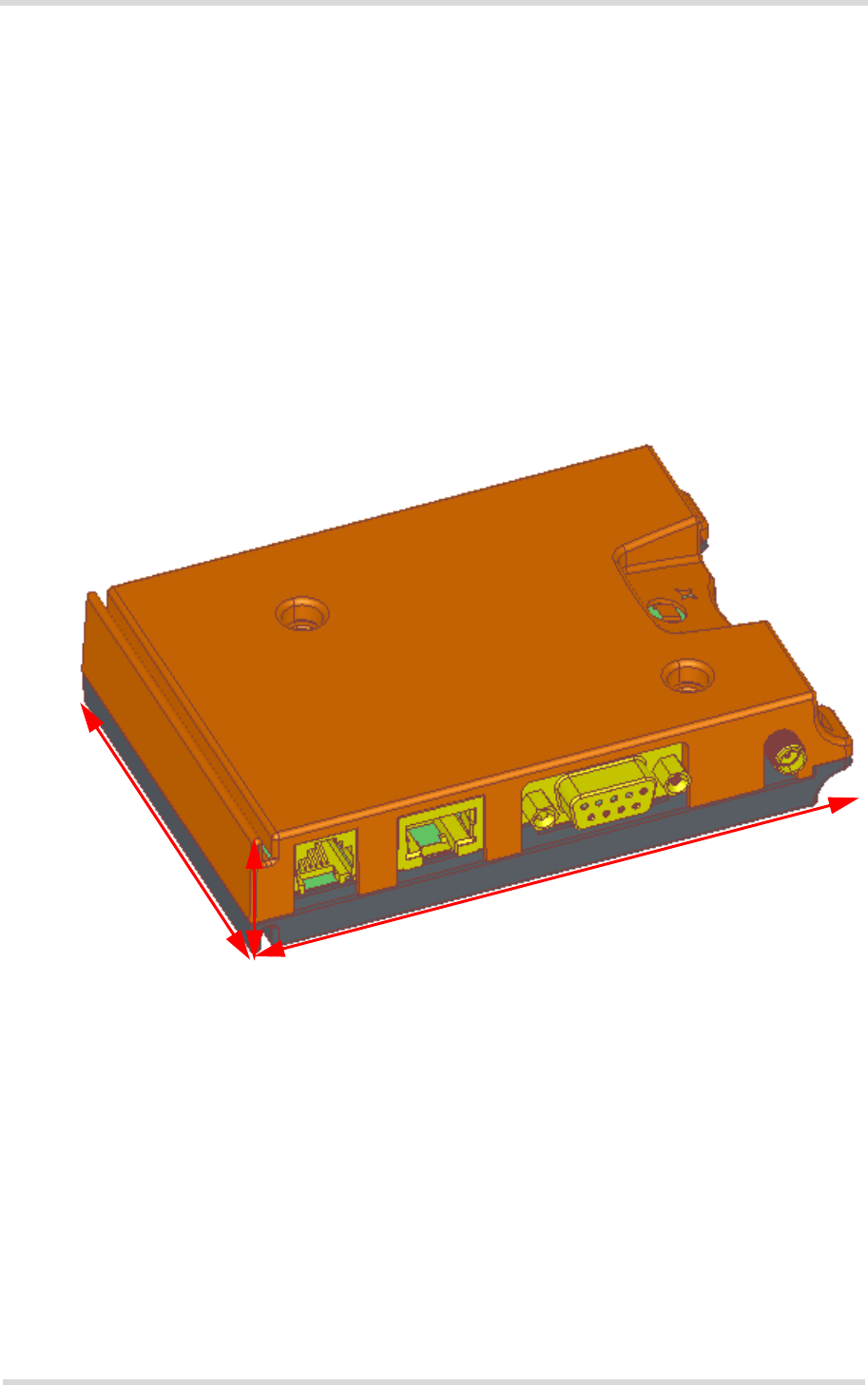
Cinterion® Java Terminals Hardware Interface Overview
4 Mechanics, Mounting and Packaging
36
EHSxT_BGS5T_HIO_v01 2014-02-26
Confidential / Preliminary
Page 33 of 41
4 Mechanics, Mounting and Packaging
4.1 Mechanical Dimensions
Figure 10 shows a 3D view of the Java Terminal and provides an overview of the mechanical
dimensions of the board. For further details see Figure 11. To allow for an easier mechanical
implementation into an external application a set of 3D STP data for the Java Terminals is at-
tached to this PDF. Please open the Attachments navigation panel to view and save these files.
Figure 10: Java Terminals 3D overview
Length: 113.5mm (including fixtures for cable straps)
Width: 75mm (excluding antenna and serial interface connectors)
Height: 25.5mm
Weight: 120g
113.5mm
75mm
25.5mm
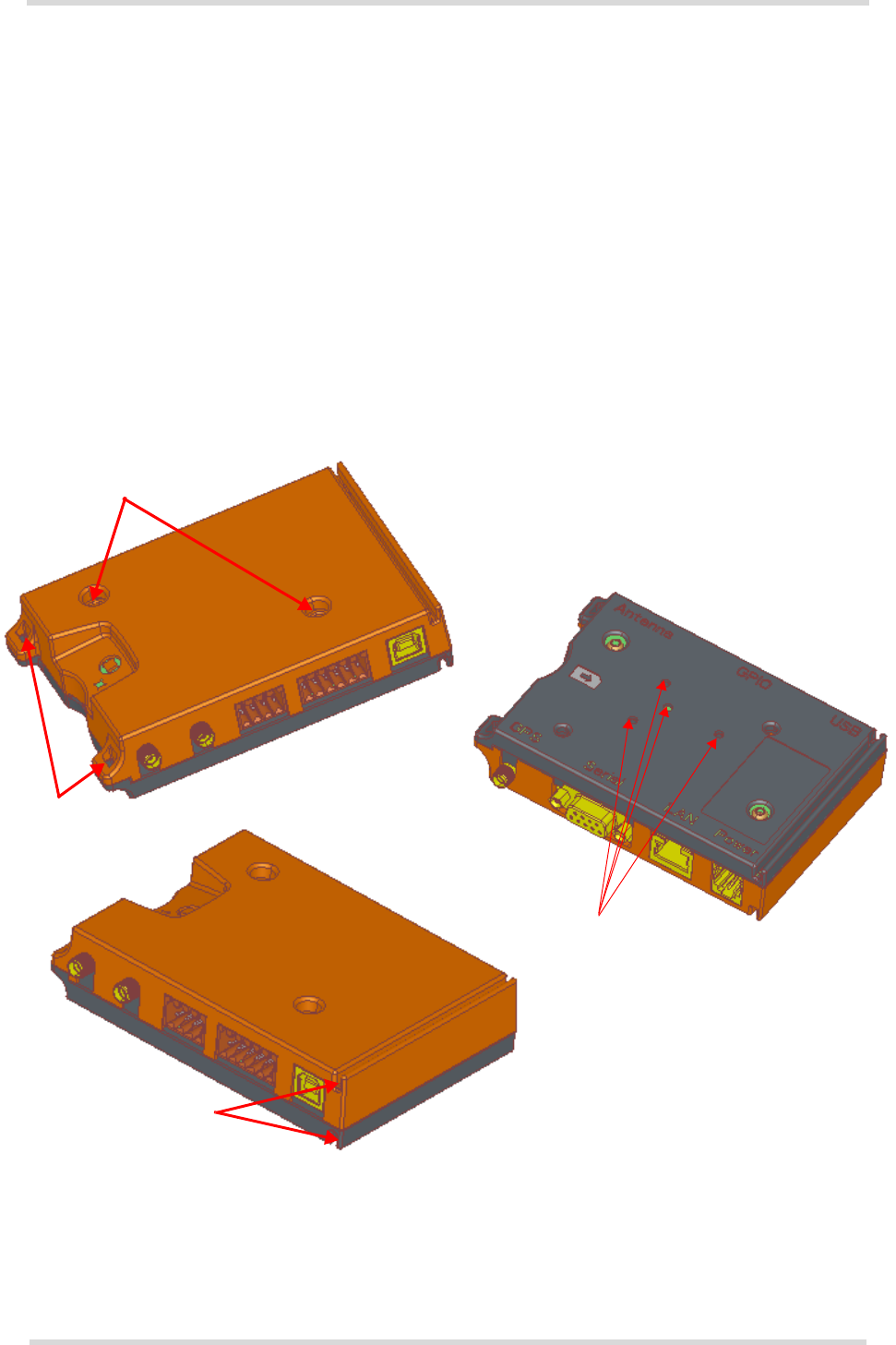
Cinterion® Java Terminals Hardware Interface Overview
4.2 Mounting the Java Terminals
36
EHSxT_BGS5T_HIO_v01 2014-02-26
Confidential / Preliminary
Page 35 of 41
4.2 Mounting the Java Terminals
There are a number of ways to mount the Java Terminals:
• Java Terminals can be attached to a rail installation or other surface using the two provided
screw holes.
• Java Terminals can be fastened to a rack or holding using the two provided fixtures for
cable straps.
• Java Terminals can be slid onto a specific DIN rail made according to DIN EN 60715 - C
section, C30 format. A catch at the terminal’s bottom side will have to be removed to slide
multiple terminals onto a single rail.
• Using a BOPLA TSH 35-2 universal DIN rail holder the Java Terminals can be fitted onto
another special type of DIN rail made according to DIN EN 60715 - Top hat section, 35mm
(e.g., Wago 210-113 steel carrier rail).
The following figure shows the various possibilities provided to mount the Java Terminals.
Figure 12: Mounting the Java Terminals
The various ways to mount the Java Terminals may be combined where appropriate. It is for
example possible to slide the terminal onto a DIN rail and in addition use cable straps to fasten
it to a holding.
Catch to mount
Screw holes for
Screw holes
Fixtures for
cable straps
DIN rail holder
C-rail (C30)
BOPLA TSH 35-2
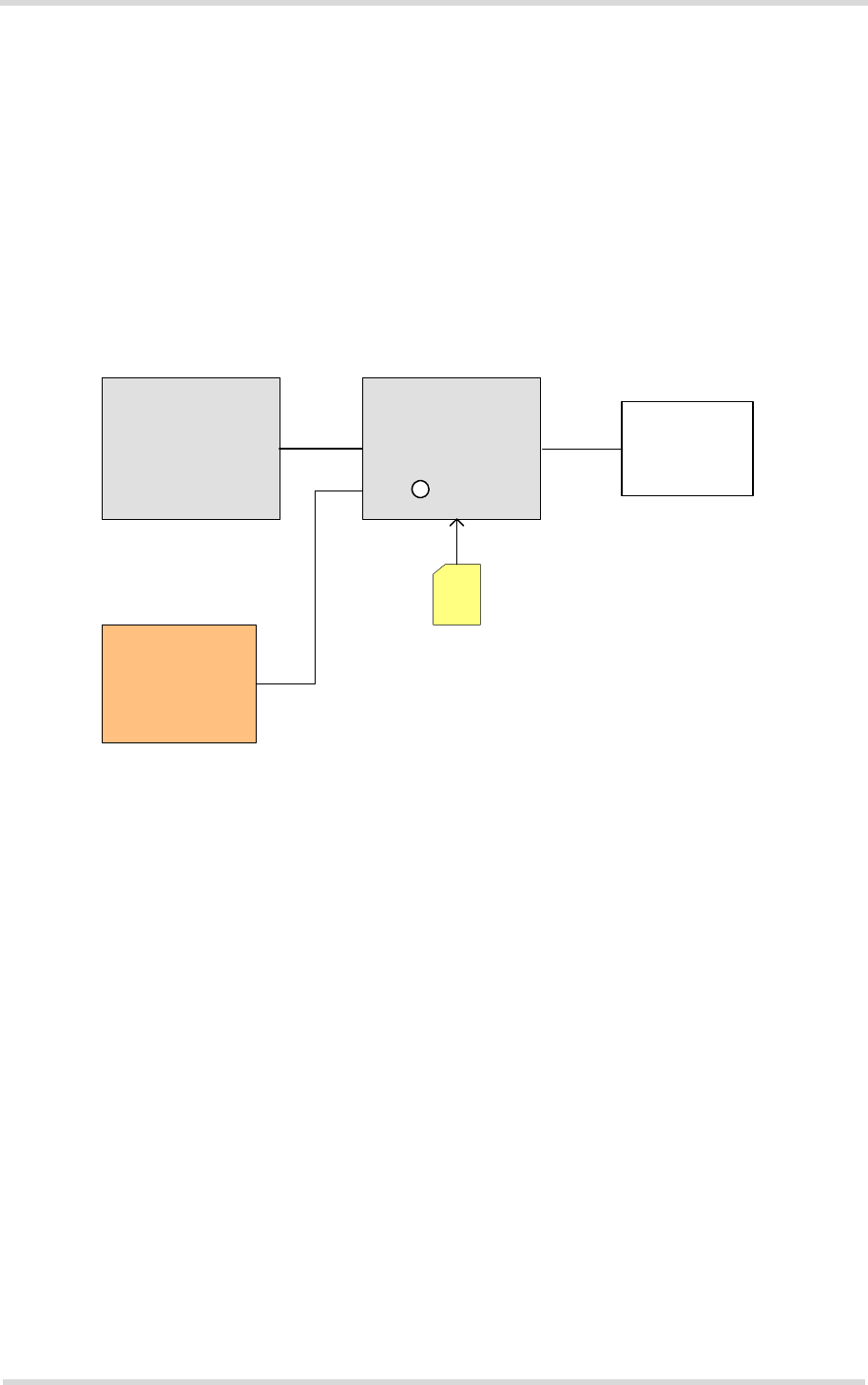
Cinterion® Java Terminals Hardware Interface Overview
5 Full Type Approval
39
EHSxT_BGS5T_HIO_v01 2014-02-26
Confidential / Preliminary
Page 37 of 41
5 Full Type Approval
5.1 Gemalto M2M Reference Setup
The Gemalto M2M reference setup submitted to type approve Java Terminals consists of the
following components:
• Java Terminals with approved Java module
•PC as MMI
• Power Supply
Figure 13: Reference equipment for approval
For ordering information please refer to Chapter 6.
PC
Power supply
SIM
RS-232
or
USB Java
Terminal
Antenna
or
50Ohm cable
to the
system simulator
ARP

Cinterion® Java Terminals Hardware Interface Overview
5.2 Restrictions
39
EHSxT_BGS5T_HIO_v01 2014-02-26
Confidential / Preliminary
Page 38 of 41
5.2 Restrictions
Later enhancements and modifications beyond the certified configuration require extra approv-
als. Each supplementary approval process includes submittal of the technical documentation
as well as testing of the changes made.
• No further approvals are required for customer applications that comply with the approved
Java Terminals configuration.
• Extra approval must be obtained for applications using other accessories than those
included in the approved Java Terminals configuration (power supply, MMI implementation
supported by AT commands).
5.3 CE Conformity
The Java Terminals meet the requirements of the EU directives listed below:
• R&TTE Directive 1999/5/EC
5.4 EMC
The Java Terminals comply with the equipment requirements specified in EN 301489-1, -7 and
-24 are covered by the R&TTE Directive.

Cinterion® Java Terminals Hardware Interface Overview
5.5 Compliance with FCC Rules and Regulations
39
EHSxT_BGS5T_HIO_v01 2014-02-26
Confidential / Preliminary
Page 39 of 41
5.5 Compliance with FCC Rules and Regulations
As an integrated product, the Java Terminals EHS6T-USB, EHS6T-LAN and BGS5T are fully
compliant with the grant of the FCC Equipment Authorization issued for the built-in Java mod-
ule, and therefore, bears the label “Contains FCC ID QIPEHS6” or “Contains FCC ID
QIPBGS5.
The Equipment Authorization Certification for the Java modules is listed under the following
identifiers:
FCC Idenitifier: QIPEHS6 or QIPBGS5
Industry Canada Certification Number: 7830A-EHS6 or 7830A-BGS5
Granted to Gemalto M2M GmbH
Radiofrequency radiation exposure Information:
This equipment complies with FCC radiation exposure limits set forth for an uncontrolled envi-
ronment. This equipment should be installed and operated with minimum distance of 20 cm be-
tween the radiator and your body. This transmitter must not be co-located or operating in
conjunction with any other antenna or transmitter.
Note: This terminal equipment has been tested and found to comply with the limits for a Class
B digital device, pursuant to Part 15 of the FCC Rules. These limits are designed to provide
reasonable protection against harmful interference in a residential installation. This equipment
generates, uses and can radiate radio frequency energy and, if not installed and used in accor-
dance with the instructions, may cause harmful interference to radio communications. Howev-
er, there is no guarantee that interference will not occur in a particular installation. If this
equipment does cause harmful interference to radio or television reception, which can be de-
termined by turning the equipment off and on, the user is encouraged to try to correct the inter-
ference by one or more of the following measures:
• Reorient or relocate the receiving antenna.
• Increase the separation between the equipment and receiver.
• Connect the equipment into an outlet on a circuit different from that to which the receiver is
connected.
• Consult the dealer or an experienced radio/TV technician for help.
Changes or modifications made to this equipment not expressly approved by Cinterion may
void the FCC authorization to operate this equipment.
This device contains UMTS, GSM and GPRS class functions in the 900, 1800 and 2100MHz
bands that are not operational in U.S. Territories. This device is to be used only for mobile and
fixed applications.
Users and installers must be provided with antenna installation instructions and transmitter op-
erating conditions for satisfying RF exposure compliance: For more information on the RF an-
tenna interface please refer to Section 3.13 and Section 4.6.
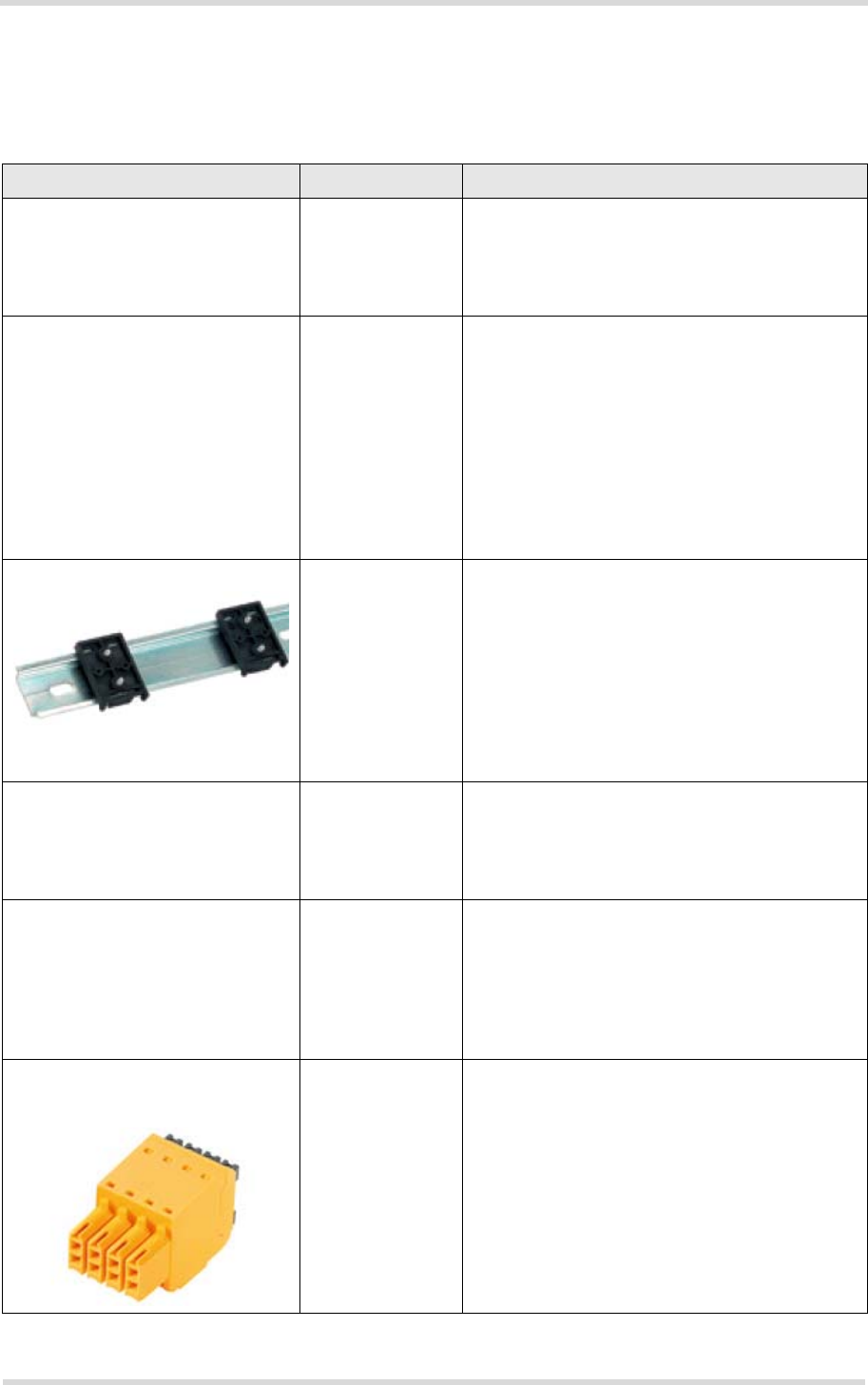
Cinterion® Java Terminals Hardware Interface Overview
6 List of Parts and Accessories
40
EHSxT_BGS5T_HIO_v01 2014-02-26
Confidential / Preliminary
Page 40 of 41
6 List of Parts and Accessories
Table 15: List of parts and accessories
Description Supplier Ordering information
Java Terminals Gemalto M2M Ordering number
EHS5T: L30960-N2730-A100
EHS6T-USB: L30960-N2740-A100
EHS5T-LAN: L30960-N2750-A100
BGS5T: L30960-N2720-A100
Power supply unit Gemalto M2M Terminal Power Supply
Ordering number: L36880-N8490-A12
UK adapter for Terminal Power Supply
Ordering number: L36880-N8490-A13
US adapter for Terminal Power Supply
Ordering number: L36880-N8490-A14
AU adapter for Terminal Power Supply
Ordering number: L36880-N8490-A15
DIN rail holder - BOPLA TSH 35-2 BOPLA Ordering number: 20035000
BOPLA Gehäuse Systeme GmbH
Borsigstr. 17-25
D-32257 Bünde
Phone: +49 (0)5223 / 969 - 0
Fax: +49 (0)5223 / 969 - 100
Email: iinfo@bopla.de
Web: http://www.bopla.de
Antenna - SMARTEQ-MiniMAG
Dualband, 0dBd, 2.6m RG174,
SMA (m)
KÖBEL Mobile
Communication Ordering number: 1140.26 with crimped SMA
connector
KÖBEL Mobile Communication
Sesamstrasse 12
D-24632 Lentföhrden
RS-232 cable with 9-pin D-sub
connector (male) Tecline Ordering number: 300574
Tecline GmbH
Behrener Straße 8
D-66117 Saarbrücken
Phone: +49-681-926-78-70
Fax: +49-681-926-78-555
Web: http://www.tecline-edv.de/
8-pin and 12-pin header connec-
tor (male) for Weidmueller GPIO
interface
Weidmueller Ordering number (12-pin): 1277510000
Ordering number (8-pin): 1277480000
Weidmüller Interface GmbH & Co. KG
Klingenbergstraße 16
D-32758 Detmold
Phone: +49 5231 14-0
Fax: +49 5231 14-2083
Email: iinfo@weidmueller.de
Web: http://www.weidmueller.com

41
M2M.GEMALTO.COM
About Gemalto
Gemalto (Euronext NL0000400653 GTO) is the world leader in digital security with 2011 annual
revenues of €2 billion and more than 10,000 employees operating out of 74 offices and 14 Research
& Development centers, located in 43 countries.
We are at the heart of the rapidly evolving digital society. Billions of people worldwide increasingly
want the freedom to communicate, travel, shop, bank, entertain and work - anytime, everywhere
- in ways that are enjoyable and safe. Gemalto delivers on their expanding needs for personal
mobile services, payment security, authenticated cloud access, identity and privacy protection,
eHealthcare and eGovernment efficiency, convenient ticketing and dependable machine-to-
machine (M2M) applications.
Gemalto develops secure embedded software and secure products which we design and
personalize. Our platforms and services manage these secure products, the confidential data they
contain and the trusted end-user services they enable. Our inovations enable our clients to offer
trusted and convenient digital services to billions of individuals.
Gemalto thrives with the growing number of people using its solutions to interact with the digital
and wireless world.
For more information please visit
m2m.gemalto.com, www.facebook.com/gemalto, or Follow@gemaltom2m on twitter.
Gemalto M2M GmbH
St.-Martin-Str. 60
81541 Munich
Germany
© Gemalto 2014. All rights reserved. Gemalto, the Gemalto logo, are trademarks and service marks of Gemalto and are registered in certain countries. April 2013
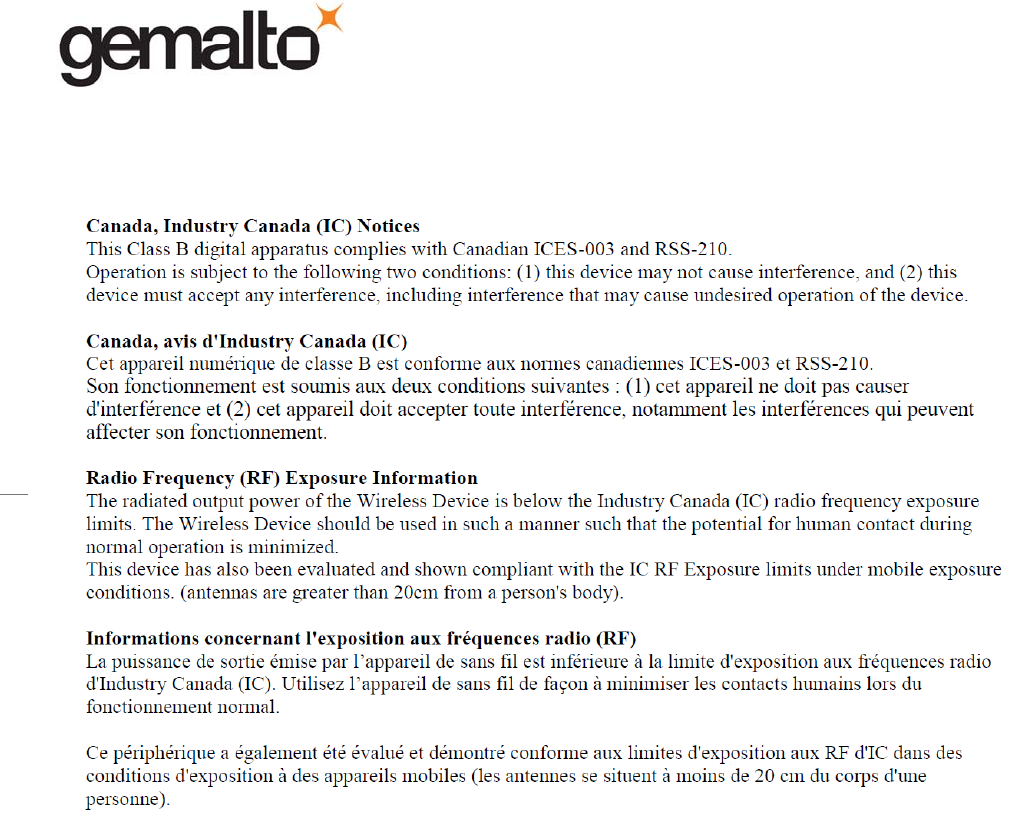
www.gemalto.com/m2m
Registered Office:
Gemalto M2M GmbH
St.-Martin-Str. 60
81541 Munich
Germany
Managing Directors:
Norbert Muhrer, Sébastien Gallois
Commercial register, Reg. No.:
A
mtsgericht München, HRB 172715
WEEE-Reg.-Nr. DE 58893809
Gemalto M2M GmbH Siemensdamm 50 13629 Berlin Germany

